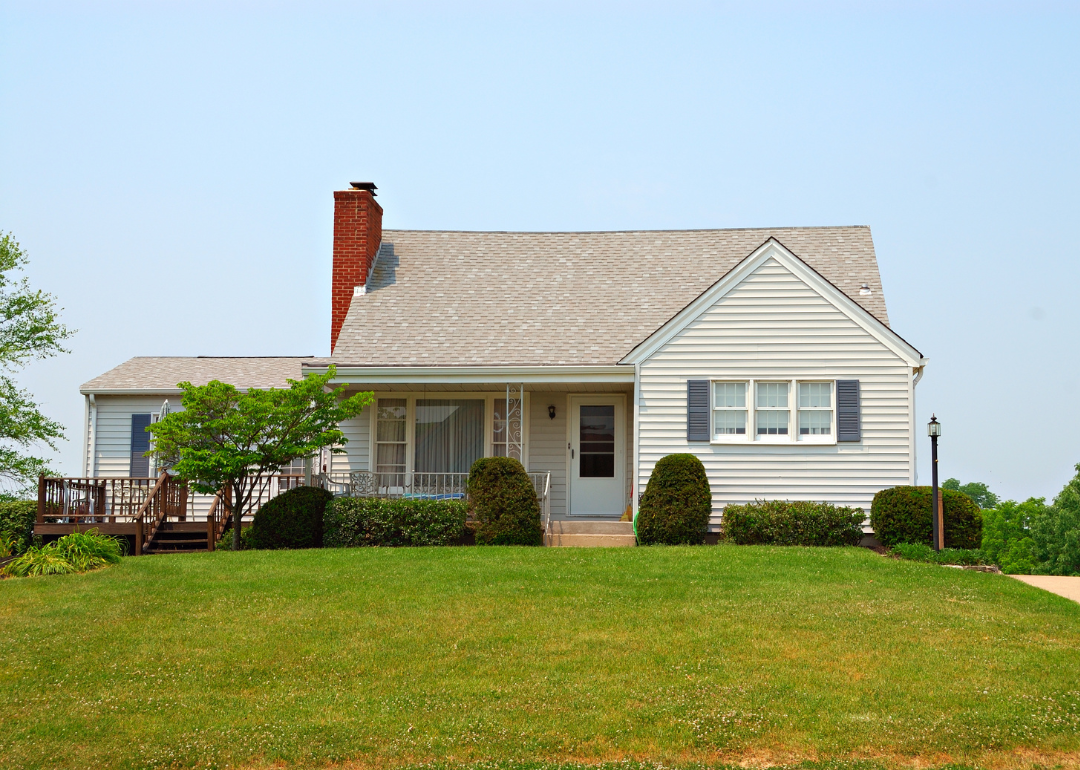
How much the typical home cost in your state in 1950
This story originally appeared on Orchard and was produced and distributed in partnership with Stacker Studio.
How much the typical home cost in your state in 1950
Suburban development in the United States exploded following World War II, with suburban populations almost doubling from 1950 to 1970.
Orchard analyzed U.S. Census Bureau data to find the 1950 median home values for every state plus Washington D.C. States are ranked in order of median home price, from lowest to highest. Also included for comparison is the median home value for each state and D.C. from 2019 (the most recent census data available).
The household median income in the U.S. in 1950 was $2,990 — roughly 40% of the median home value of $7,354 at the time, according to census data. By 2010, household median income was $49,445 — or 22% of the $221,800 median home value. The median income in 2021 hovers around the same percentage of median home costs.
Keep in mind that other changes to American life spurred homeownership expansion during this time: Pent-up demand for housing encouraged the construction of new homes, while the growth of the national highway system eased commutes and allowed people to live further from cities. Housing finance reforms under the New Deal and funds from the G.I. Bill made buying a home suddenly attainable for huge swaths of Americans, although the former reinforced racial segregation while the latter left out many Black veterans who served in World War II.
Keep reading to discover the median home cost in your state in 1950 — and scroll to the bottom for more information on the methodology.
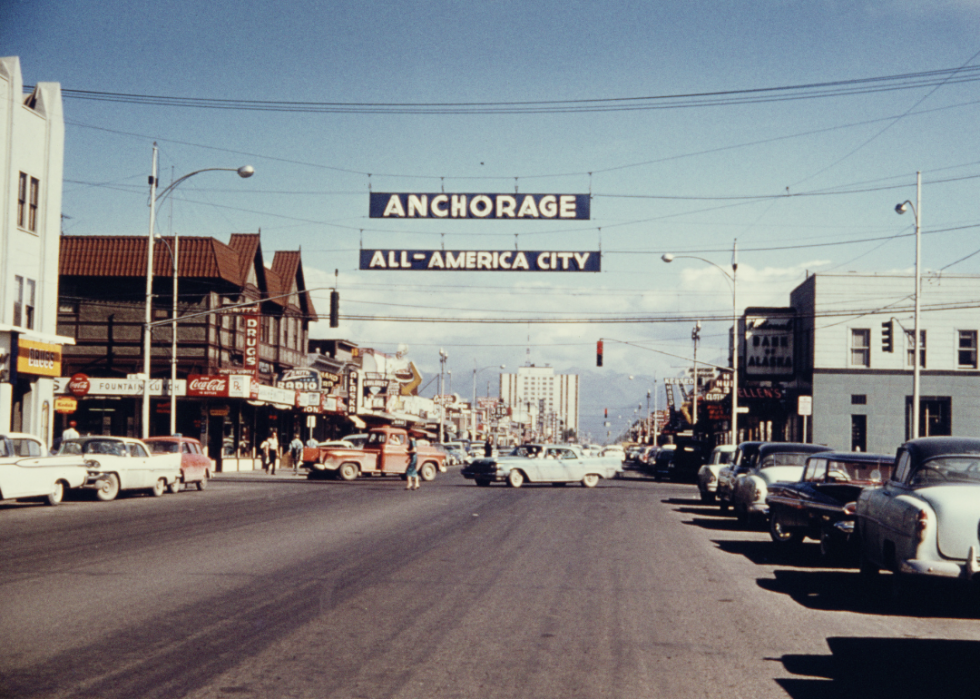
#51. Alaska
- Median home value in 1950: $3,477
- Median home value (adjusted for inflation): $39,469
- Median home value in 2019: $281,200
Anchorage, Alaska, experienced a population boom in the 1940s as greater Anchorage grew from about 4,000 residents in 1939 to 32,000 in 1950 with the construction of Fort Richardson in 1940 and '41. With that explosion of people came a severe lack of housing. Those arriving in Anchorage at the time ordered kit houses or lived in makeshift campsites, mobile homes, or Quonset huts until the shortage eased.
The city remains Alaska's most populous.
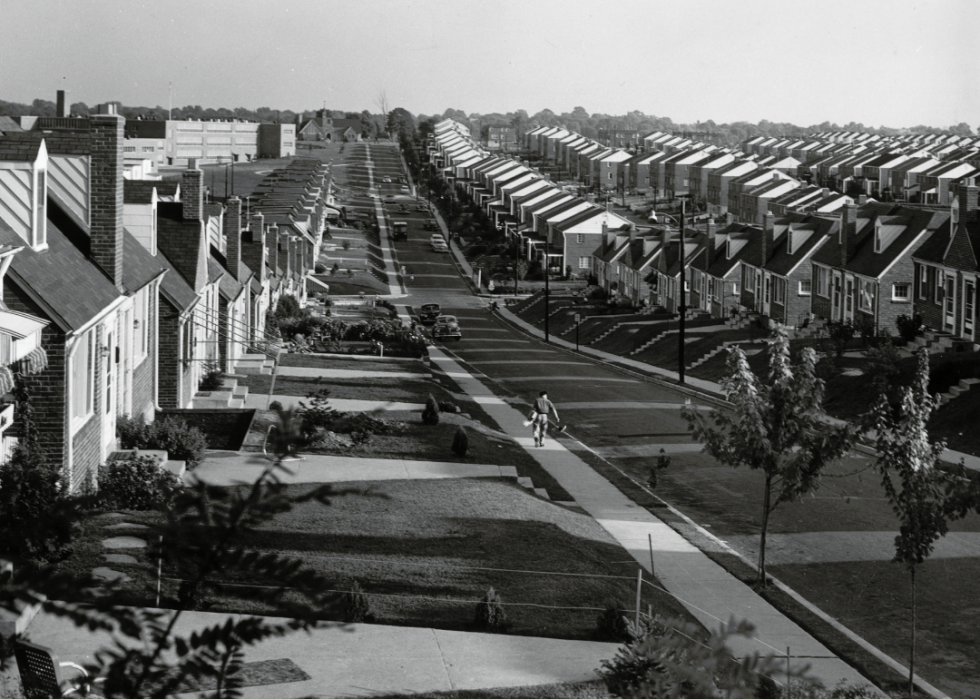
#50. Arkansas
- Median home value in 1950: $4,087
- Median home value (adjusted for inflation): $46,393
- Median home value in 2019: $136,200
Little Rock, Arkansas, housing inventory (excluding farm housing) rose from 1950 to 1960 by about 20,200 homes, according to a 1965 report by the U.S. Department of Housing and Urban Development (HUD). By April 1960, there were about 75,531 homes in the area, and by January 1965, about 84,800 homes.
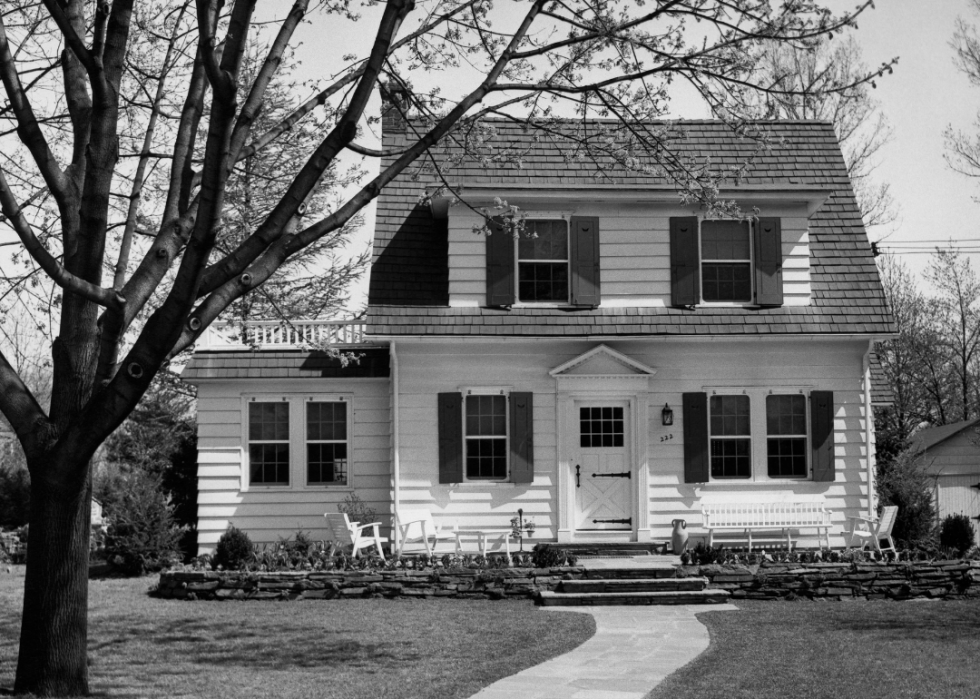
#49. Mississippi
- Median home value in 1950: $4,159
- Median home value (adjusted for inflation): $47,210
- Median home value in 2019: $128,200
Arkansas, Mississippi, and Oklahoma between 1940 and 2000 had the lowest median home values in the country, according to census data. By 2000, the value of homes in the southern states still lagged, along with those in North and South Dakota. Seven percent of all housing in Mississippi was built between 1950 and 1959. In Birmingham, formerly redlined areas are still largely segregated and fetch lower property values than nearby neighborhoods throughout the city.
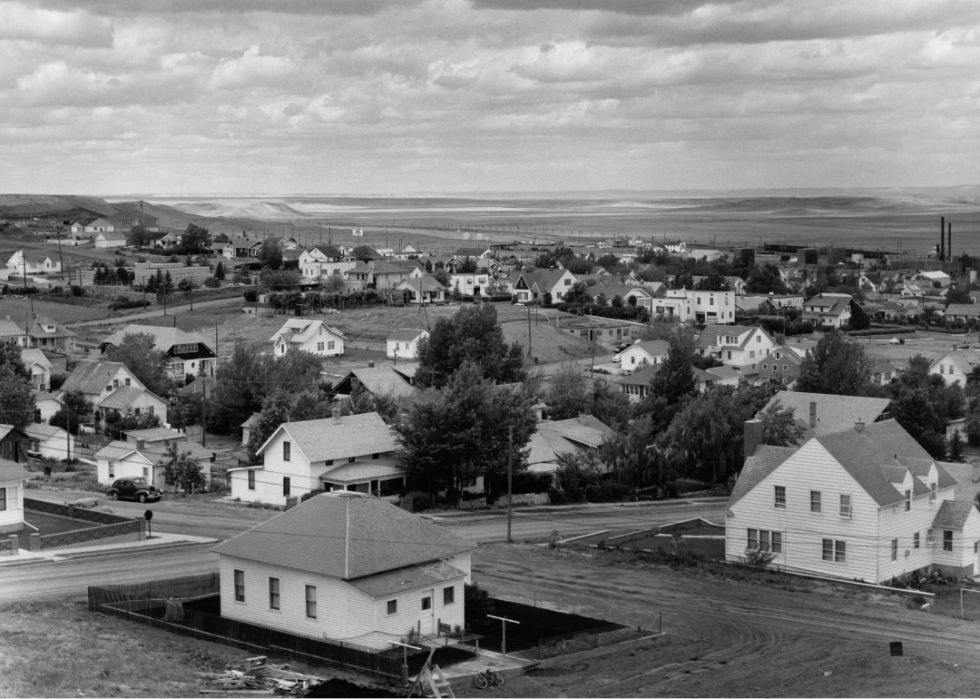
#48. Alabama
- Median home value in 1950: $4,473
- Median home value (adjusted for inflation): $50,774
- Median home value in 2019: $154,000
Between 1950 and 1960, the number of households in the Birmingham, Alabama, area increased on average by 2,825, according to HUD. The population continued to grow at a slightly slower pace, 1.5% versus 1.8%, until 1960 when there were 196,300 households in the area. On average, 4,925 new homes were approved each year during the decade between 1950 and 1960, as measured by building permits.
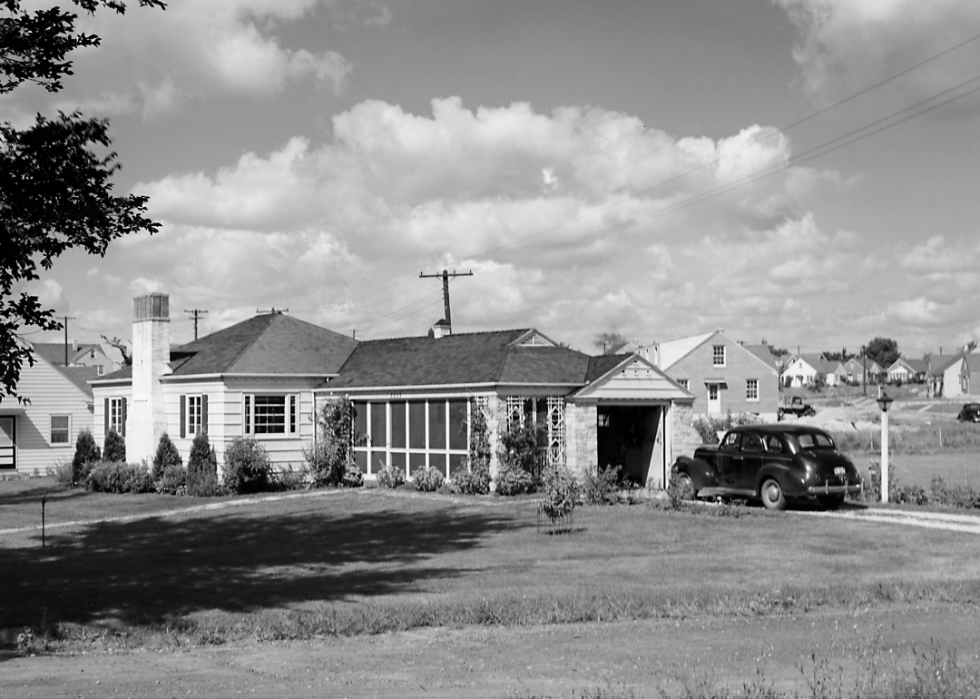
#47. Maine
- Median home value in 1950: $4,856
- Median home value (adjusted for inflation): $55,122
- Median home value in 2019: $200,500
As late as 1950, about half of the homes in Maine state did not have plumbing or were in other ways substandard. Over the next 20 years, about 100,000 families—or about a third of the state's population—were able to move into new homes. By 1970, only about 6% of the state's households lived in substandard housing thanks to urban renewal and public housing and the USDA's former Farmers Home Administration, according to an analysis by Maine Policy Review.
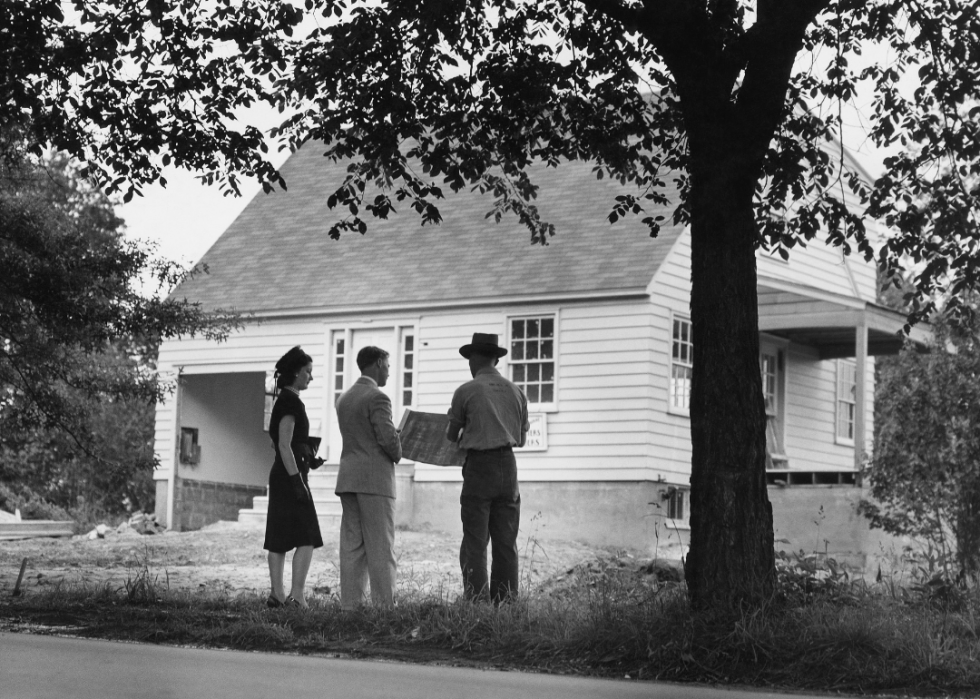
#46. North Carolina
- Median home value in 1950: $4,901
- Median home value (adjusted for inflation): $55,633
- Median home value in 2019: $193,200
In the decade between 1950 and 1960, about 1,425 households were added to the population of the Raleigh, North Carolina, area each year, according to a 1968 HUD report. That increased to about 1,850 from 1960 to 1968, resulting in about 55,500 nonfarm households by the start of 1968. Much of this growth can be attributed to the 1966 move of International Business Machines (IBM) into Raleigh.
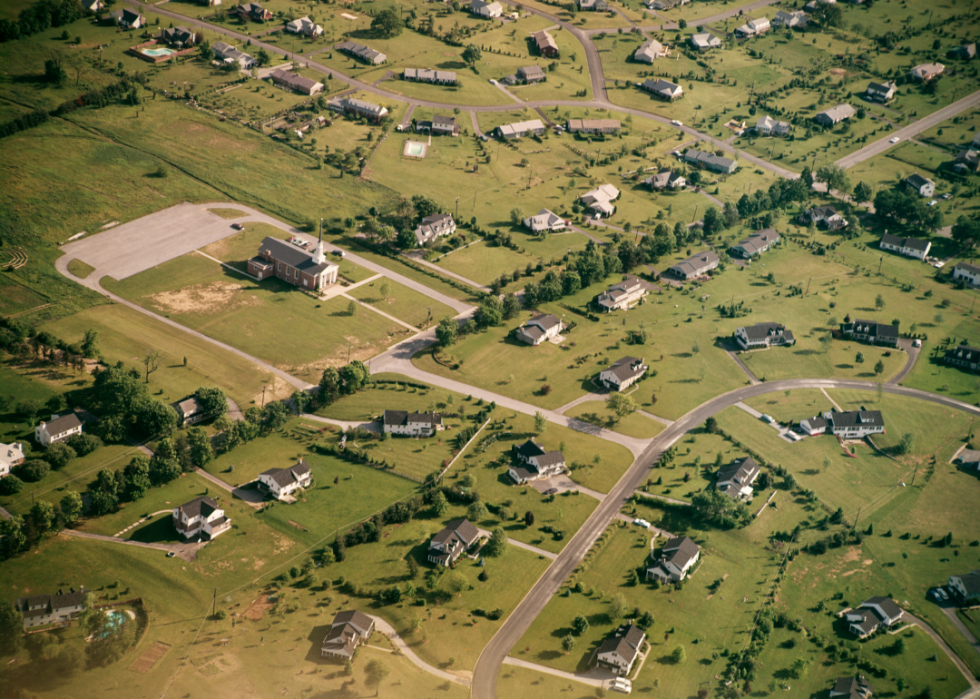
#45. South Carolina
- Median home value in 1950: $5,112
- Median home value (adjusted for inflation): $58,028
- Median home value in 2019: $179,800
The 1950s were a period of intense development throughout South Carolina and the rest of the country. In addition to suburban neighborhoods rising out of previously undeveloped farmland, several urban renewal projects throughout the state involved demolishing low-income communities in favor of constructing upper-middle-class residential communities. Controversial "slum clearance programs" earned Columbia, South Carolina, two All-America City Awards by the National Municipal League and Look magazine in 1951 and 1964. Many of the state's best-ranked towns today were constructed in whole or in part in the 1950s.
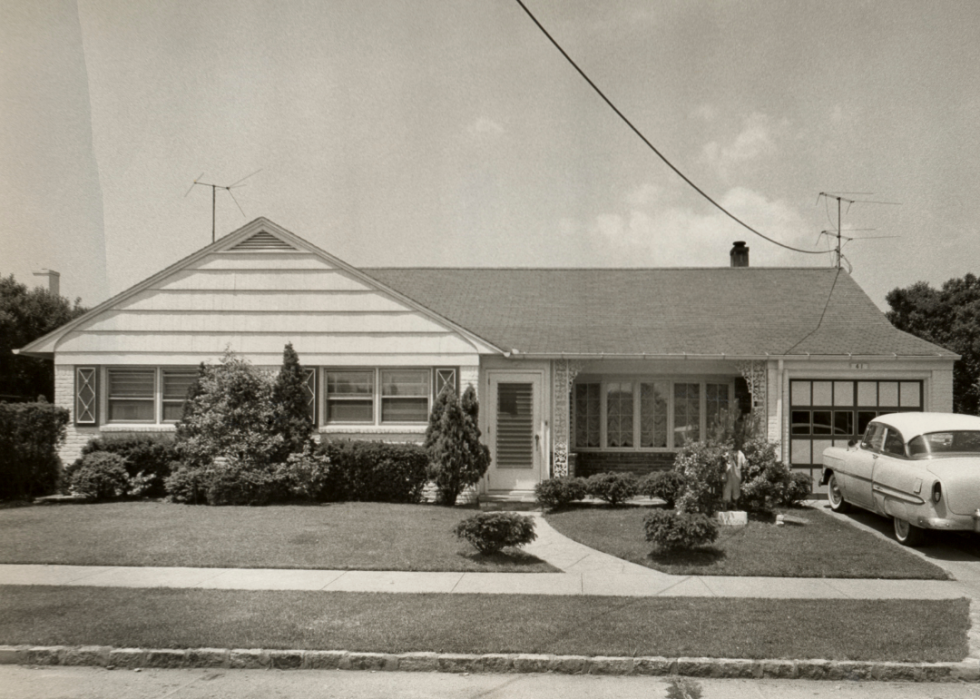
#44. Louisiana
- Median home value in 1950: $5,141
- Median home value (adjusted for inflation): $58,357
- Median home value in 2019: $172,100
In addition to the housing shortage brought about by the Great Depression and World War II, Louisiana's population rose by almost 1 million between 1940 and 1960, from 2,363,880 to 3,257,022. In 1940, 41% of its residents lived in urban areas, but by 1960 that share had risen to 63%. The first houses built to ease the shortage were called G.I. specials, which were small boxy structures, but by 1950 they had given way to ranch homes.
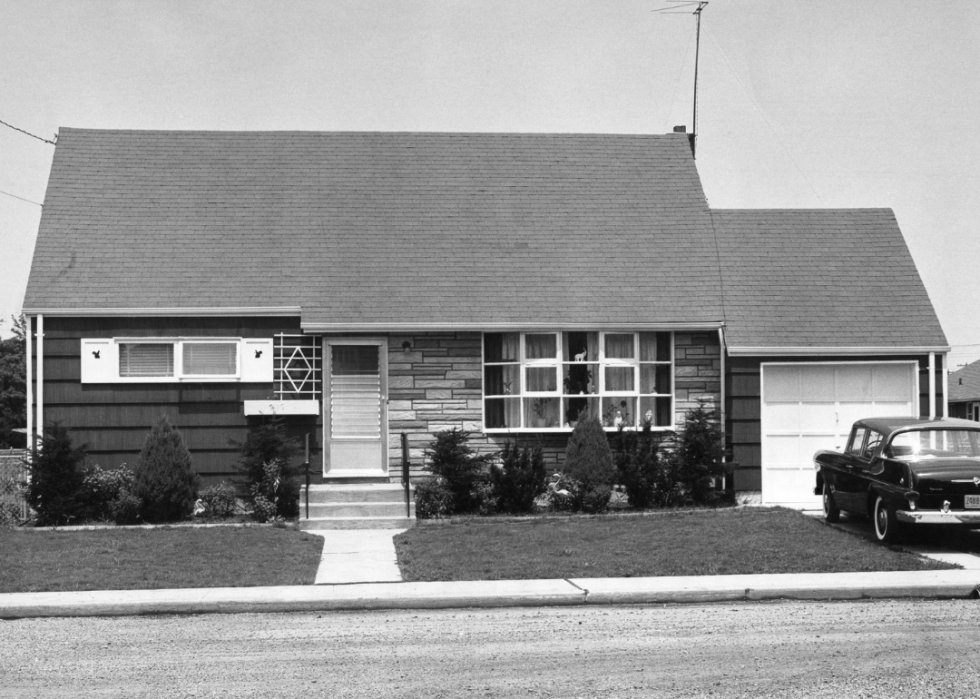
#43. Oklahoma
- Median home value in 1950: $5,228
- Median home value (adjusted for inflation): $59,345
- Median home value in 2019: $147,000
In the state's two largest cities, the decade between 1950 and 1960 saw populations grow and homes constructed for the new residents. Each year, Oklahoma City had on average an additional 4,975 homes built for an average of 13,225 additional people. In Tulsa, Oklahoma, known as the oil capital of the world, the population increased from 252,686 in 1950 to 346,038 in 1960, when one-fifth of the city's employment was connected to the oil industry.
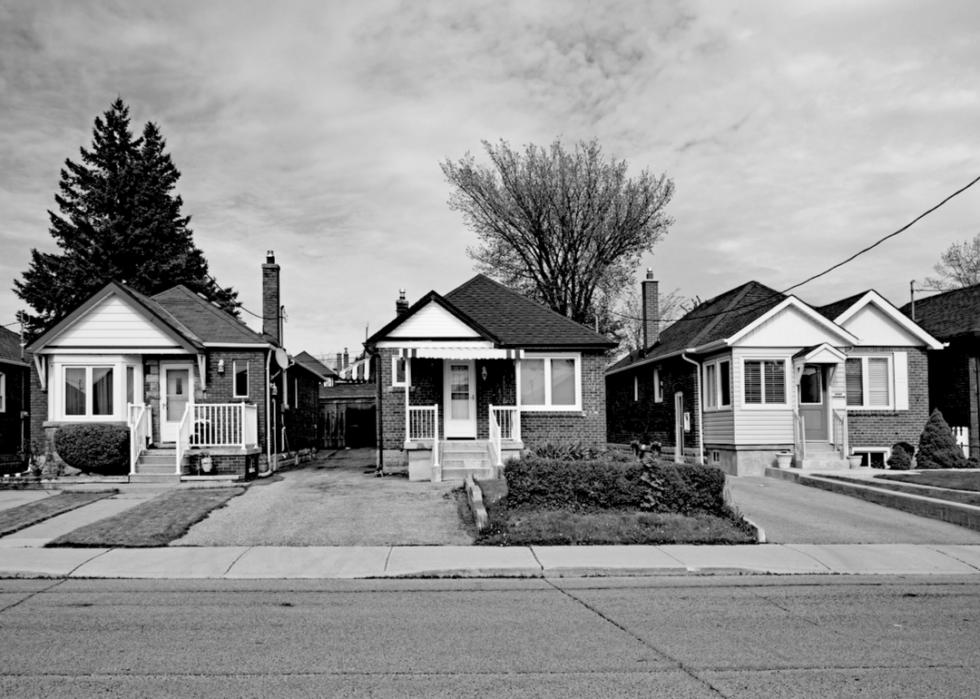
#42. Georgia
- Median home value in 1950: $5,235
- Median home value (adjusted for inflation): $59,424
- Median home value in 2019: $202,500
After World War II, Southern cities like Atlanta moved from farm-based to industrial-based economies. Transportation—trains, airplanes, and the new interstate highway system—increased access to these cities and helped them thrive. No Southern city had a population of 1 million in 1950; Atlanta reached that milestone in 1959. Elsewhere, in the area that includes Athens, the number of households grew on average by 280 a year in the decade between 1950 and 1960. Some 4,125 homes were built in that decade, more than twice that of the decade before.
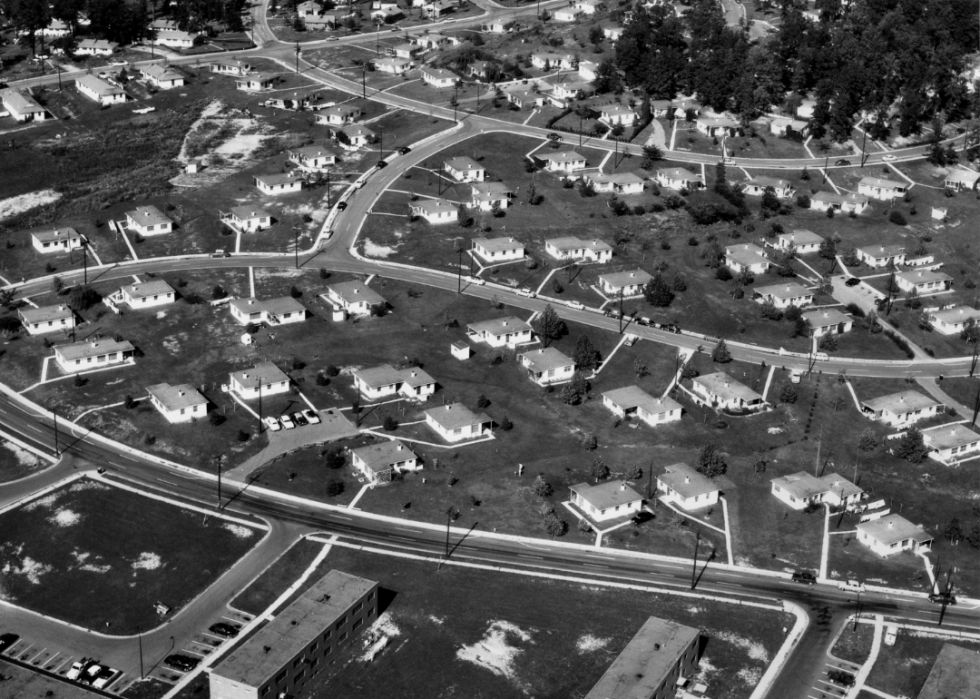
#41. Tennessee
- Median home value in 1950: $5,268
- Median home value (adjusted for inflation): $59,799
- Median home value in 2019: $191,900
From 1950 to 1960, the Nashville, Tennessee, metro area grew by about 7,799 people or 2,589 households each year. The number of new homes increased by about 2,720 a year over the same period as measured by building permits. Of those, 75% were single-family homes. A little over half, 52.9%, were occupied by the owners.
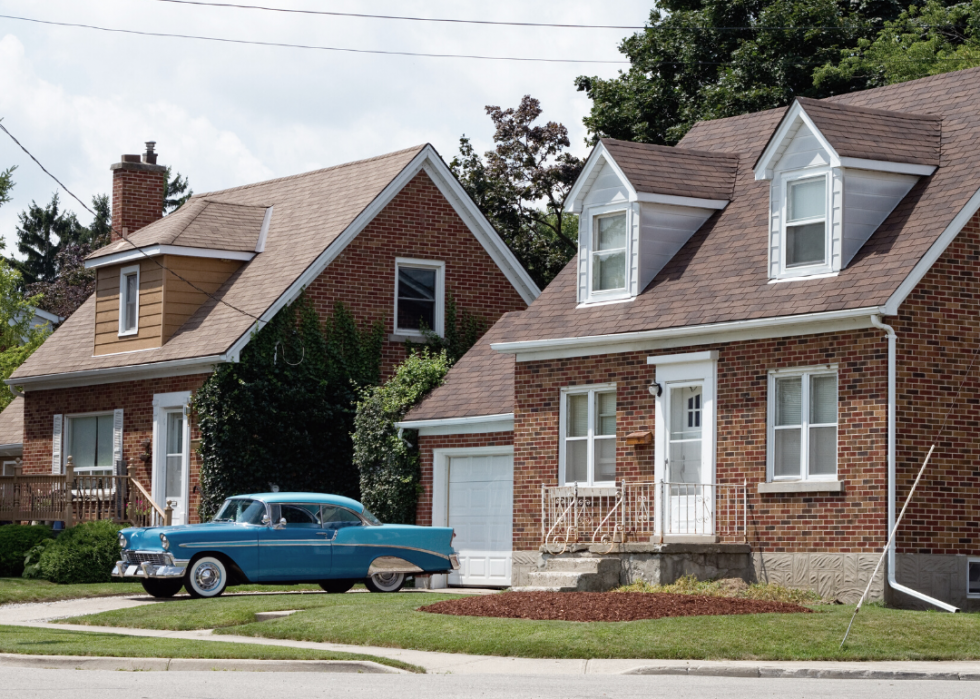
#40. Kentucky
- Median home value in 1950: $5,283
- Median home value (adjusted for inflation): $59,969
- Median home value in 2019: $151,700
About 2,351 subdivisions were laid out around Louisville, Kentucky, in Jefferson County between 1921 and 1969—nearly 66% of which were constructed between 1950 and 1970, according to the Kentucky Archaeological Survey. The area exploded in growth after World War II and farmland was turned into housing tracts. The county's population grew by 25% during the 1940s and 1950s, far greater than Louisville's, which increased by 16% in the 1940s and 5% in the 1950s.
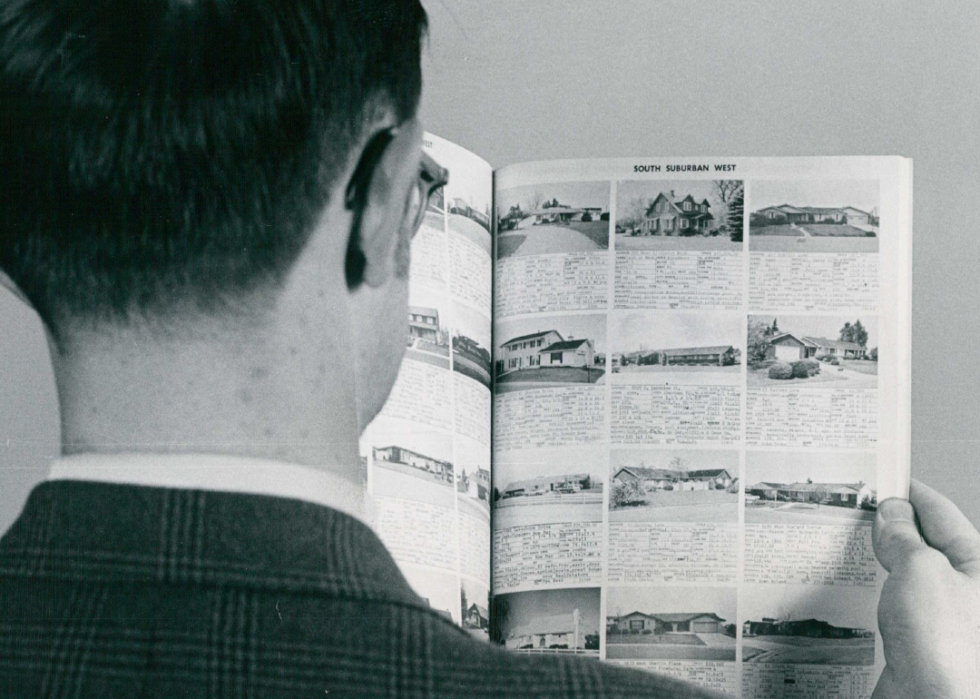
#39. North Dakota
- Median home value in 1950: $5,396
- Median home value (adjusted for inflation): $61,252
- Median home value in 2019: $205,400
Through its various programs and incentives, the Federal Housing Administration (FHA) opened up homeownership to many first-time buyers. Its Better Housing Program encouraged new homeowners to improve resale values and overall function with projects requiring woodworkers, electricians, plumbers, or other tradespeople.
On its website, the State Historical Society of North Dakota highlights a 1935 house still standing in Bismarck that was built as part of a national competition to introduce the country to the new (at the time) FHA that had been established the year prior.
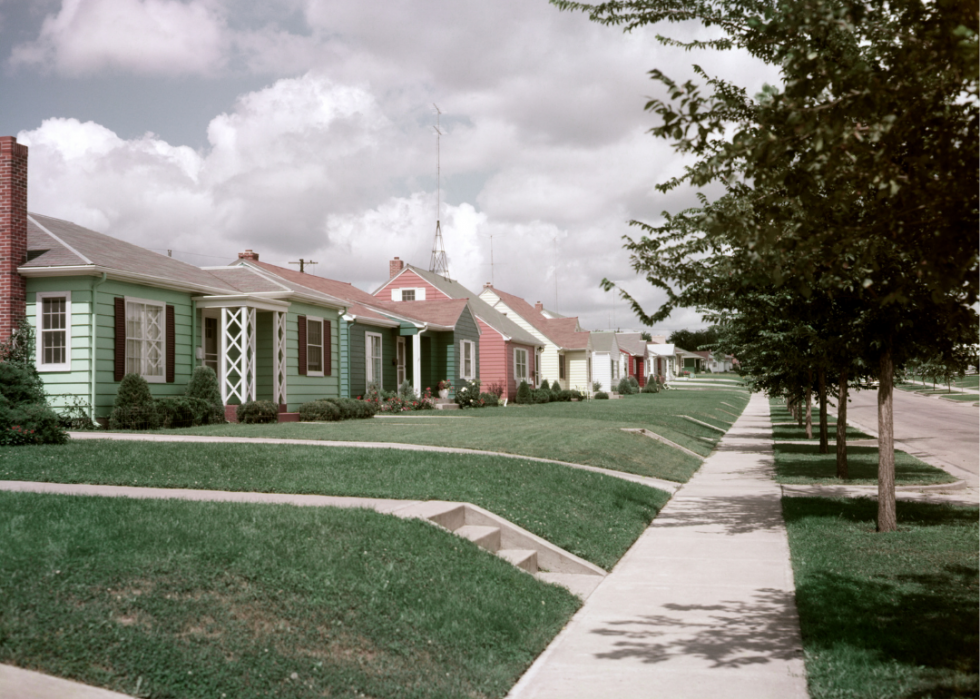
#38. South Dakota
- Median home value in 1950: $5,410
- Median home value (adjusted for inflation): $61,411
- Median home value in 2019: $185,000
More than 20% of South Dakota homes were built between 1950 and 1975. The burst of homebuilding after World War II was especially evident in Sioux Falls and Rapid City, with 1950 marking the transition from the postwar period to a return to normalcy, according to a study of the architecture of homes constructed during that period. Meanwhile, foreclosures began on about 11.6 million acres of farmland from 1921 through 1950.
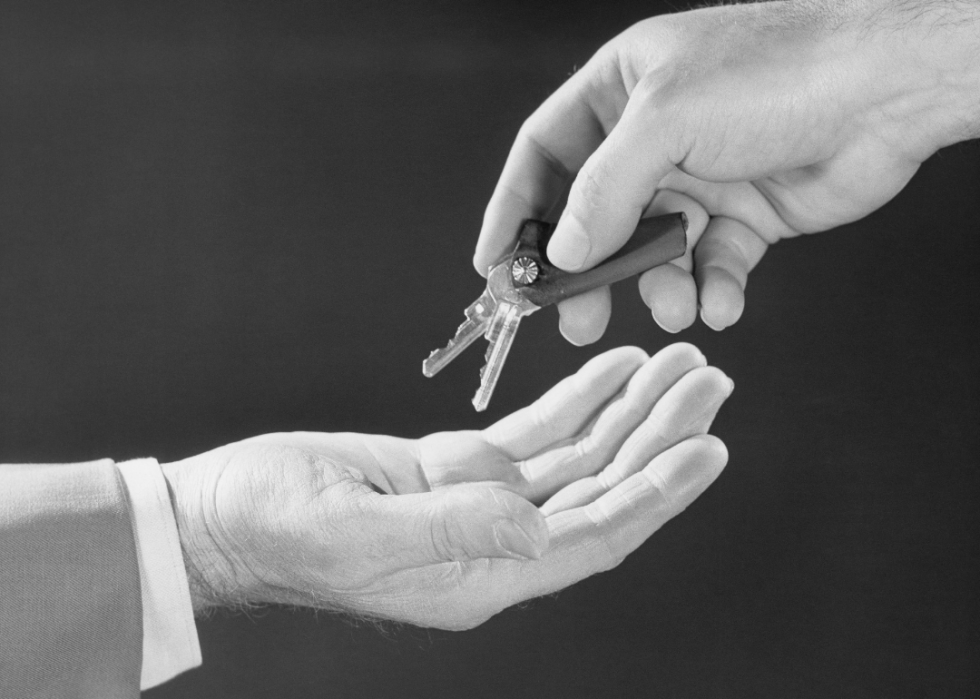
#37. Kansas
- Median home value in 1950: $5,462
- Median home value (adjusted for inflation): $62,001
- Median home value in 2019: $163,200
In addition to financial incentives for homeowners, model homes in the 1950s showcased the cutting-edge technology of the time. The "1950s All-Electric House," still on display at the Johnson County Museum in Overland Park, Kansas, was constructed in 1954 by the Kansas City Power & Light electric company. The home featured amenities including gadgets that could open the curtains and garage door, a hidden television, and a year-round air conditioner, or heat pump. The year it was built, more than 62,000 people came to view it—more than lived in Johnson County at the time.
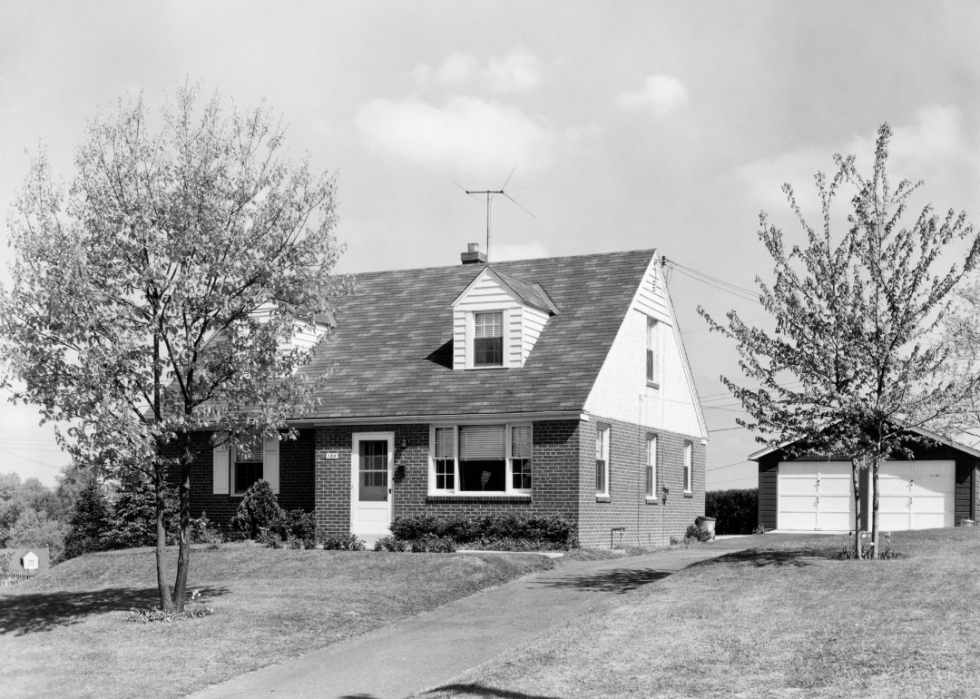
#36. West Virginia
- Median home value in 1950: $5,473
- Median home value (adjusted for inflation): $62,126
- Median home value in 2019: $124,600
Morgantown, West Virginia, grew early as an industrial center amid coal fields. But between 1950 and 1960, the area lost jobs and population. In the city itself, the population dropped by about 300 people a year, from nearly 25,550 to 22,550. In 1950, about 26% of Morgantown's homes were dilapidated or were without plumbing. By the mid-1960s, that share of poor housing had improved to 21% of the 4,000 homes.
West Virginia is the only state to have a lower population today than in 1950.
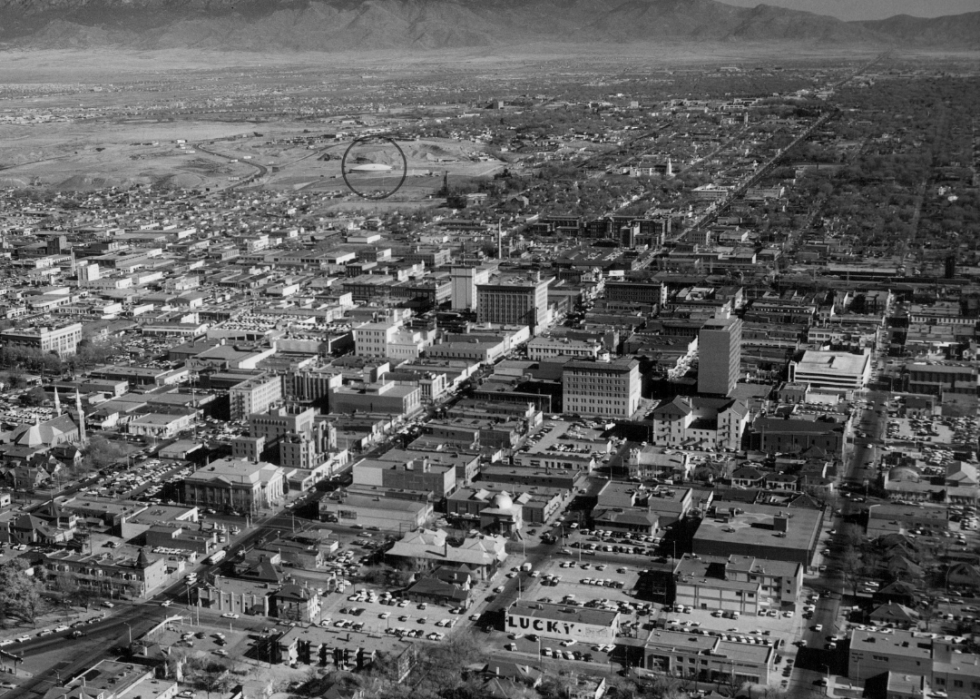
#35. New Mexico
- Median home value in 1950: $5,697
- Median home value (adjusted for inflation): $64,669
- Median home value in 2019: $180,900
The Albuquerque, New Mexico, population in 1950 was 96,815, more than double what it had been 10 years earlier, a result of people moving to the Sunbelt and to jobs at Kirtland Air Force Base and Sandia National Laboratories. The number of students at the University of New Mexico grew because of the G.I. Bill. Home prices rose in the 1950s as water lines were installed and roads were paved in new subdivisions. Despite the additional cost, homeownership increased from 62% to 68%.
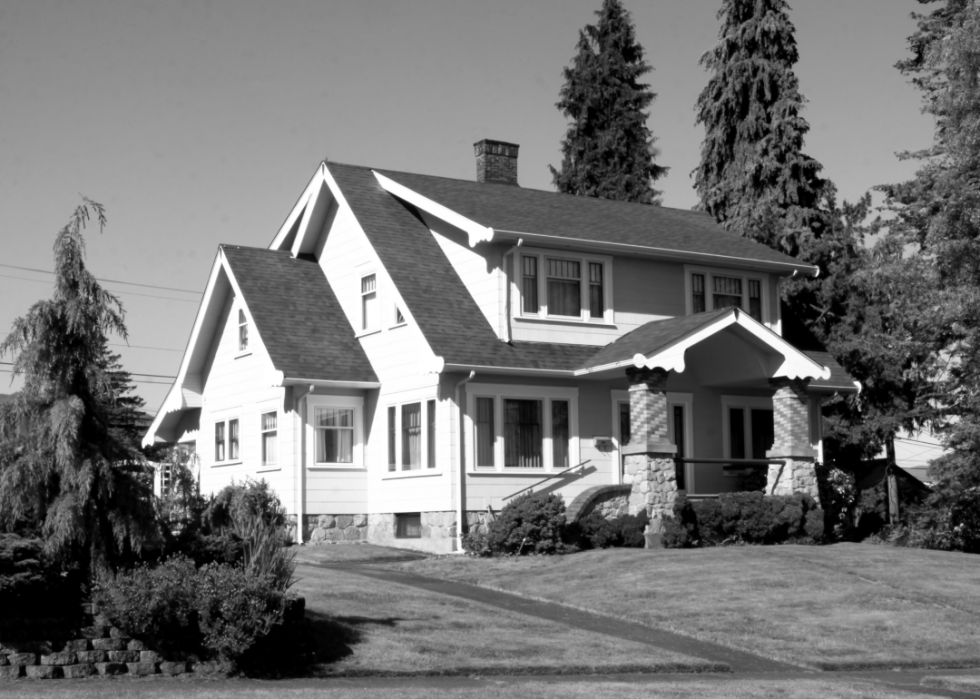
#34. Montana
- Median home value in 1950: $5,797
- Median home value (adjusted for inflation): $65,804
- Median home value in 2019: $253,600
The number of jobs in Montana grew rapidly from 1950 to 1960, partly as a result of the discovery of oil in the state's Williston Basin. In that same decade, the population increased by about 23,850 people, or by 65%. The number of homes grew rapidly, as well: 1960 census data showed 52% of Montana housing had been built after 1945.
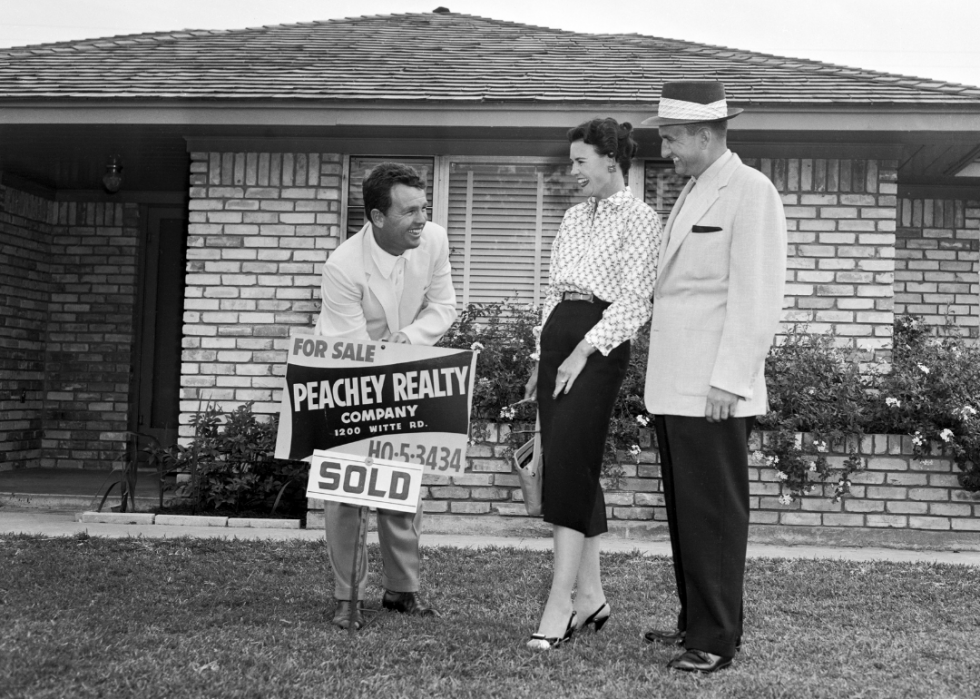
#33. Texas
- Median home value in 1950: $5,805
- Median home value (adjusted for inflation): $65,894
- Median home value in 2019: $200,400
Houston in the 1950s and 1960s was experiencing rapid growth. The decade between 1950 and 1960 saw the addition of about 43,650 people a year and 15,100 homes a year. A HUD analysis of the Houston housing market offered other signs of explosive growth after 1950: Department store sales were up 112%, annual nonresidential consumption of electricity up 410%, and nonresidential consumption of natural gas rose 165%.
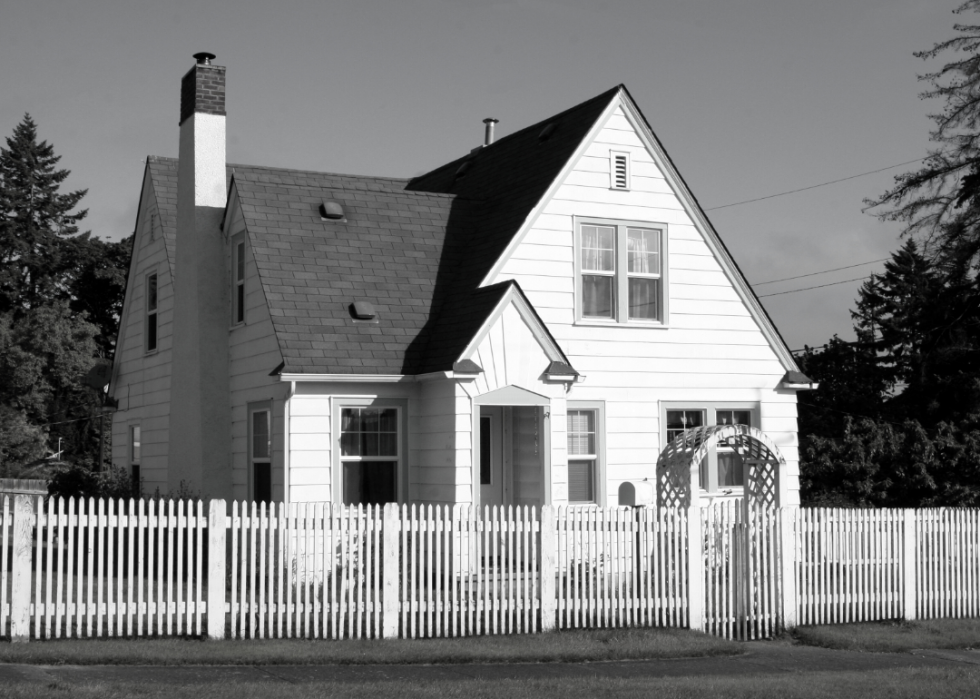
#32. Idaho
- Median home value in 1950: $5,852
- Median home value (adjusted for inflation): $66,428
- Median home value in 2019: $255,200
The population of Boise, Idaho, was 61,413 in 1950, and it grew by 2,498 in the decade that followed. Homes in the area were relatively new. By 1967, only 37% of them had been built before 1940. Rentals had a vacancy rate of about 7% in 1950, which grew to 11% a decade later.
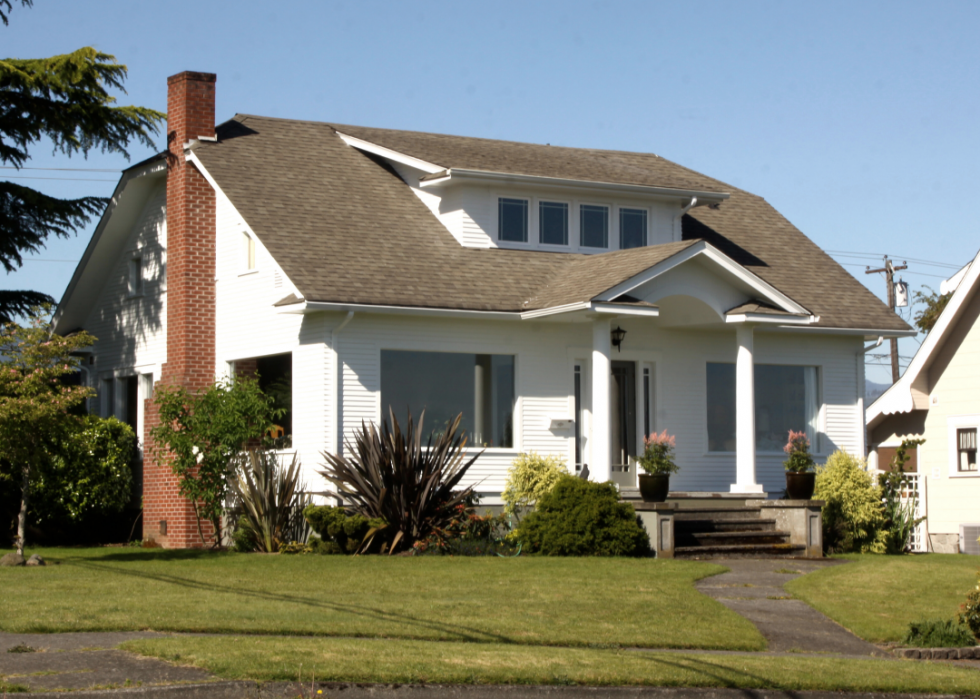
#31. Nebraska
- Median home value in 1950: $5,918
- Median home value (adjusted for inflation): $67,177
- Median home value in 2019: $172,700
The population in the Omaha, Nebraska, area was 366,395 in 1950 and increased by 91,500 to 457,873 in the following decade. There were about 107,750 homes in the area in 1950, a number that rose to 143,650 in 1960. The homes were older; in 1965, almost half had been built before 1929.
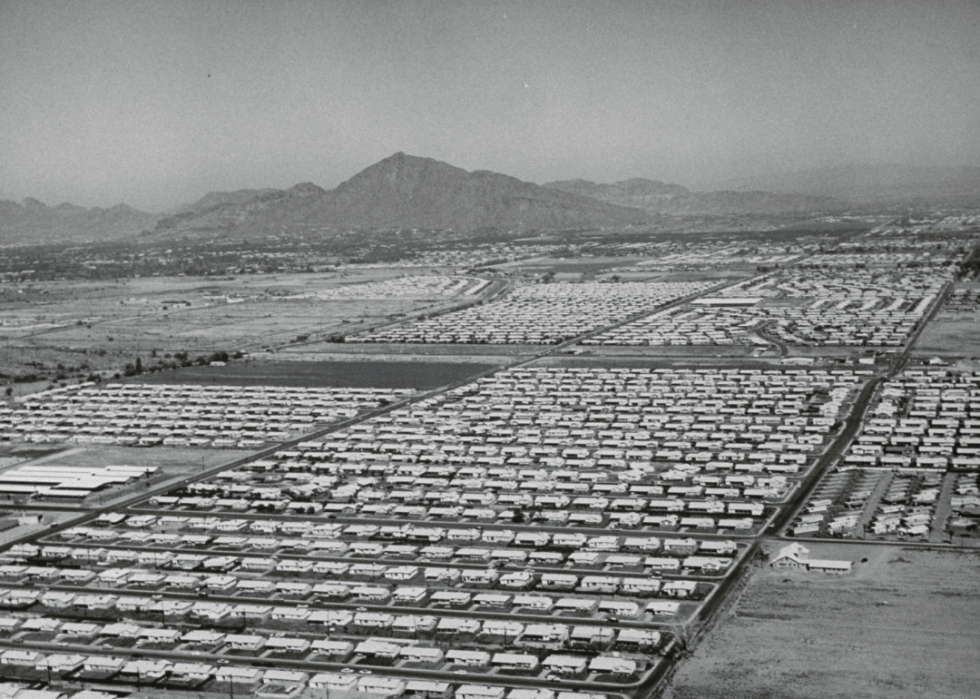
#30. Arizona
- Median home value in 1950: $5,935
- Median home value (adjusted for inflation): $67,370
- Median home value in 2019: $255,900
The population of the Phoenix area was 331,770 in 1950 and grew to 663,510 in the next decade. In 1950 there were 108,000 homes in the area, a number that nearly doubled in the decade that followed. In the decade between 1950 and 1960, the proportion of owner-occupied homes rose 57% to almost 66%.
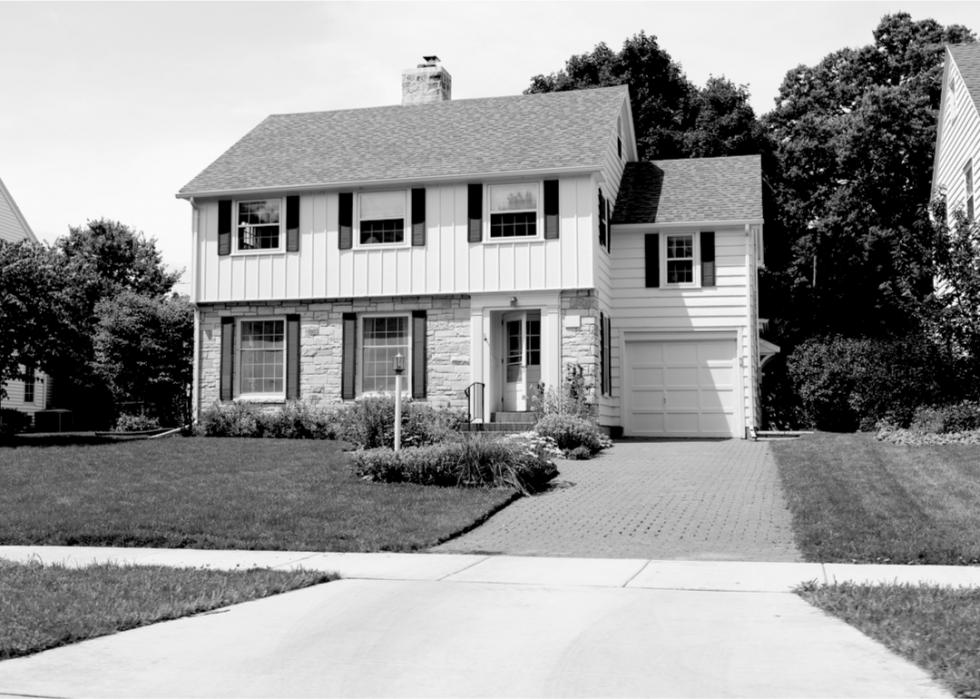
#29. New Hampshire
- Median home value in 1950: $6,199
- Median home value (adjusted for inflation): $70,367
- Median home value in 2019: $281,400
The economy of the Manchester, New Hampshire, area was known to be dominated by the textile industry, which had reached its peak during World War I. Growth in the 1950s was represented by the electrical industry. The population of the area in 1950 was 88,370, which grew to 95,512 a decade later. In 1950, there were a total of 27,169 homes in the area.
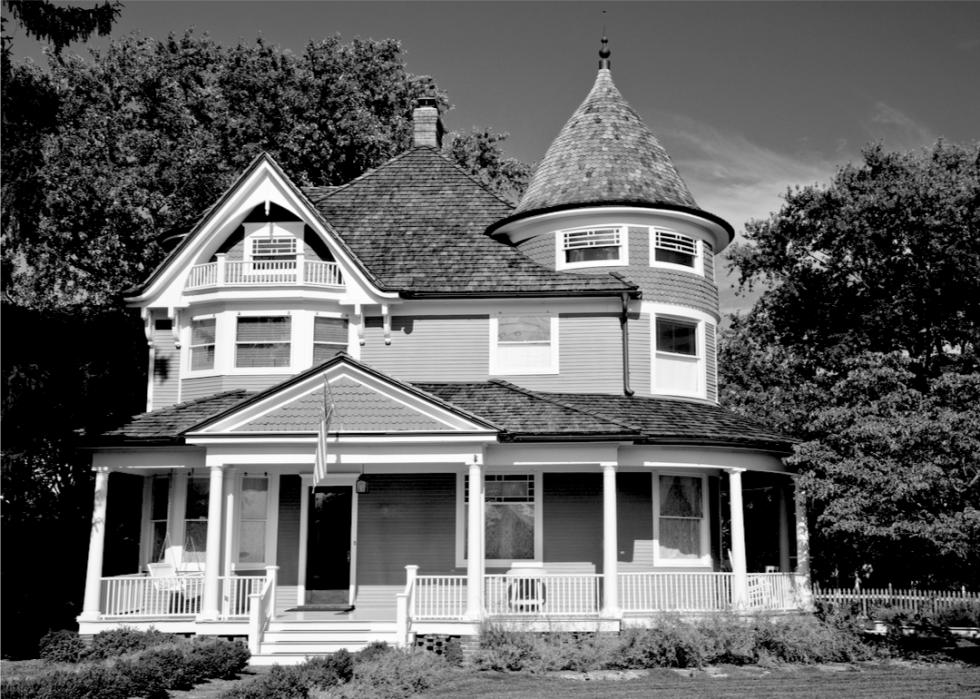
#28. Indiana
- Median home value in 1950: $6,226
- Median home value (adjusted for inflation): $70,673
- Median home value in 2019: $156,000
In 1950, single-family homes accounted for 79% of Indiana's housing stock. Apartment buildings of two to four units made up 15%, and five or more units made up 4.6%. Mobile homes accounted for only 1.1%. In 1950, the median price of a house in the United States as a whole was about 17% higher than Indiana's home value.
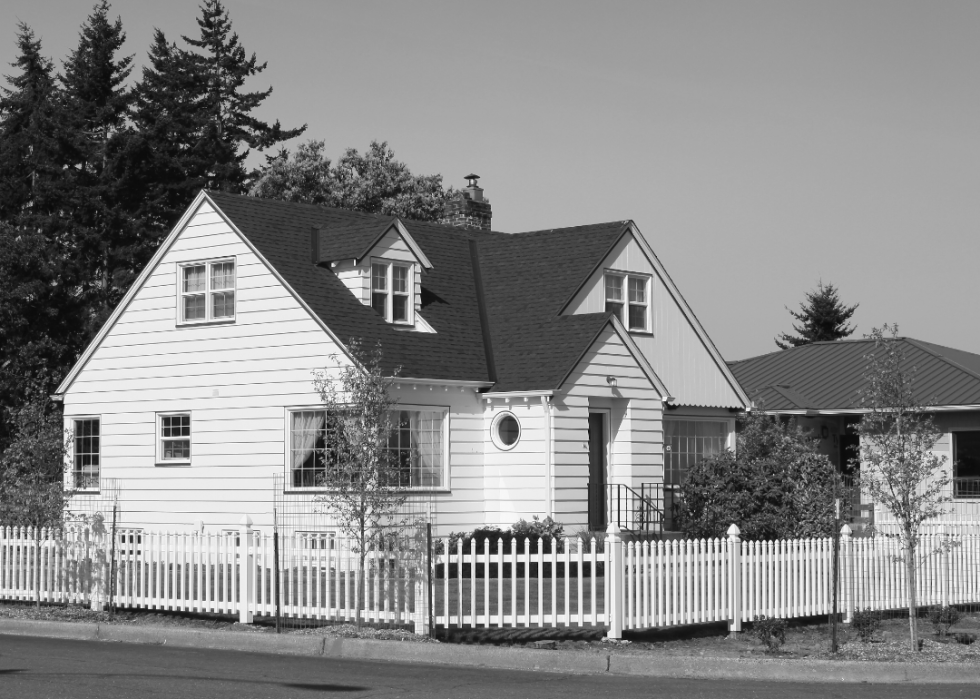
#27. Vermont
- Median home value in 1950: $6,277
- Median home value (adjusted for inflation): $71,252
- Median home value in 2019: $233,200
As of 2013, more than 45% of the homes in Burlington, Vermont, were built before 1950. Of the ones constructed between 1950 and 1972, 42% are owner-occupied; 37% were built before 1950.
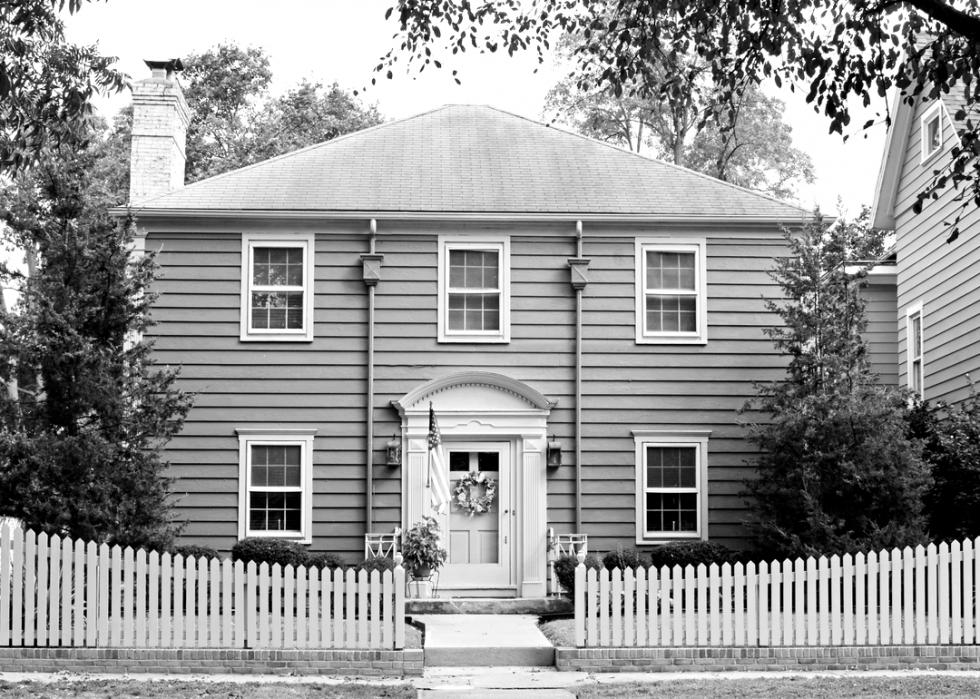
#26. Iowa
- Median home value in 1950: $6,320
- Median home value (adjusted for inflation): $71,740
- Median home value in 2019: $158,900
In Iowa City, Iowa, home to the University of Iowa, the population rose by an average of 925 or 2% each year in the decade between 1950 and 1960. The university is a major employer in the area. Manufacturing employment more than doubled in the 1950s, while jobs in education, hospitals, and services rose by more than 40%.
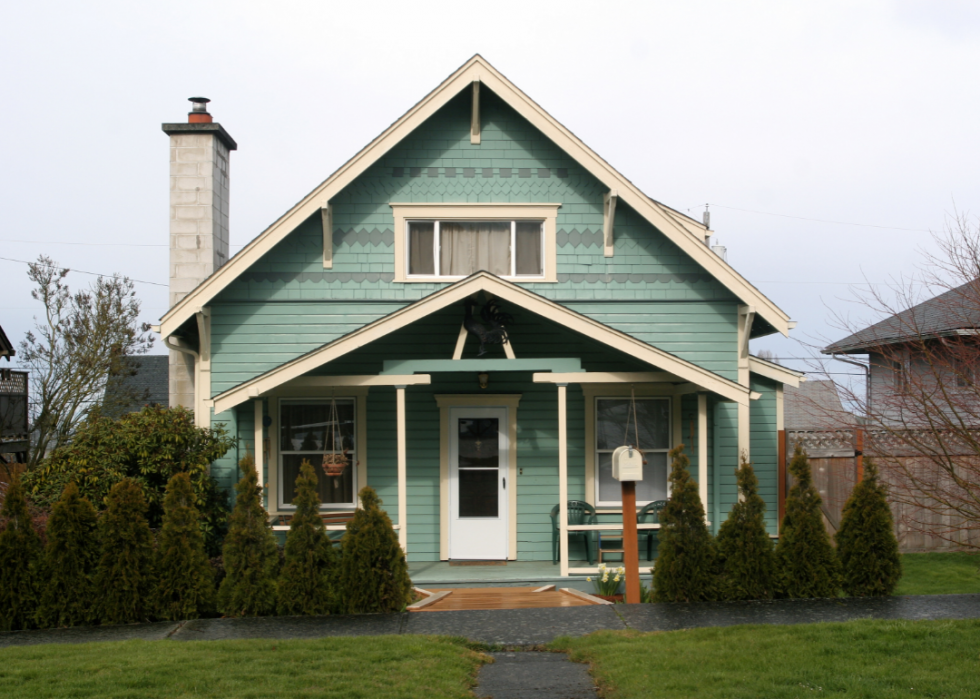
#25. Missouri
- Median home value in 1950: $6,399
- Median home value (adjusted for inflation): $72,637
- Median home value in 2019: $168,000
The area around Kansas City, Missouri, grew by 243,900 people in the 1950s. The Missouri side accounted for 59% of that growth while the Kansas side made up 41%. About 88,800 of them moved into the area to benefit from a growing economy and job opportunities. In that same period, the number of houses increased by 96,800, for a total of 372,435 by 1960.
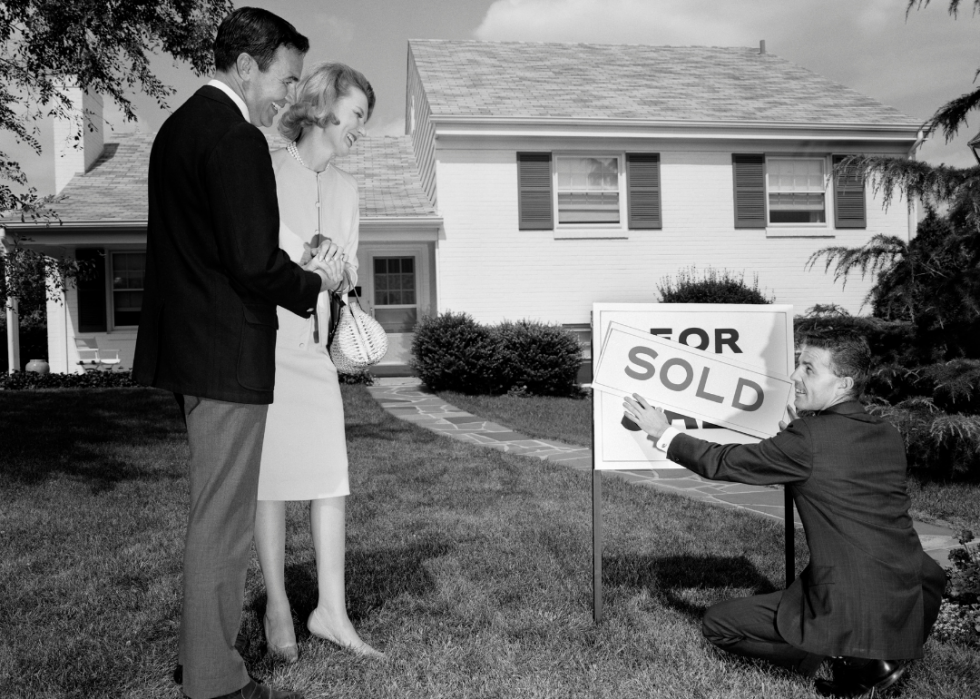
#24. Virginia
- Median home value in 1950: $6,581
- Median home value (adjusted for inflation): $74,703
- Median home value in 2019: $288,800
Despite the 1920 census showing for the first time that more Americans lived in cities and towns than rural communities, Virginia didn't reach the same milestone until 1950. The state's city populations spiked following World War II as factory and military installation jobs were plentiful. The influx of opportunity was the catalyst for explosive suburban growth around city centers, which only expanded. That growth only expanded as schools desegregated beginning in 1959.
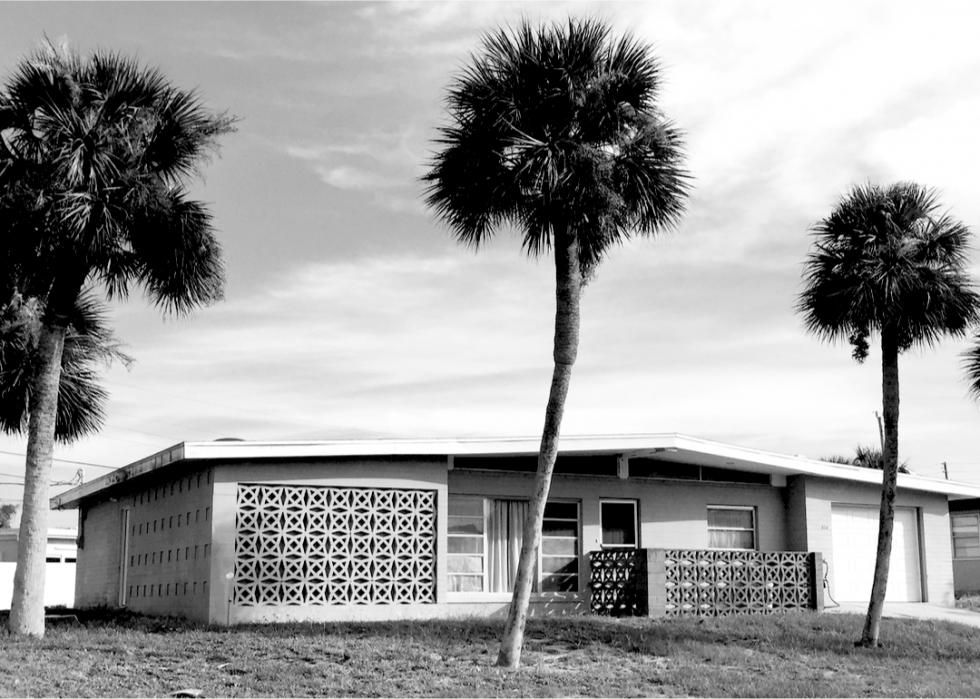
#23. Florida
- Median home value in 1950: $6,612
- Median home value (adjusted for inflation): $75,055
- Median home value in 2019: $245,100
Population growth was the name of the game throughout post-war Florida. Miami-Dade County's population grew by 84% between 1940 and 1950 to 495,000 residents. The suburbs had the most explosive growth: up 151% from 54,000 residents in 1940 to 135,000 in 1950. Fort Lauderdale's population more than tripled between 1945 and 1950 alone. New highways were quickly constructed to connect new and growing neighborhoods, towns, and cities: The Florida Turnpike was started in 1955 and completed in 1957.
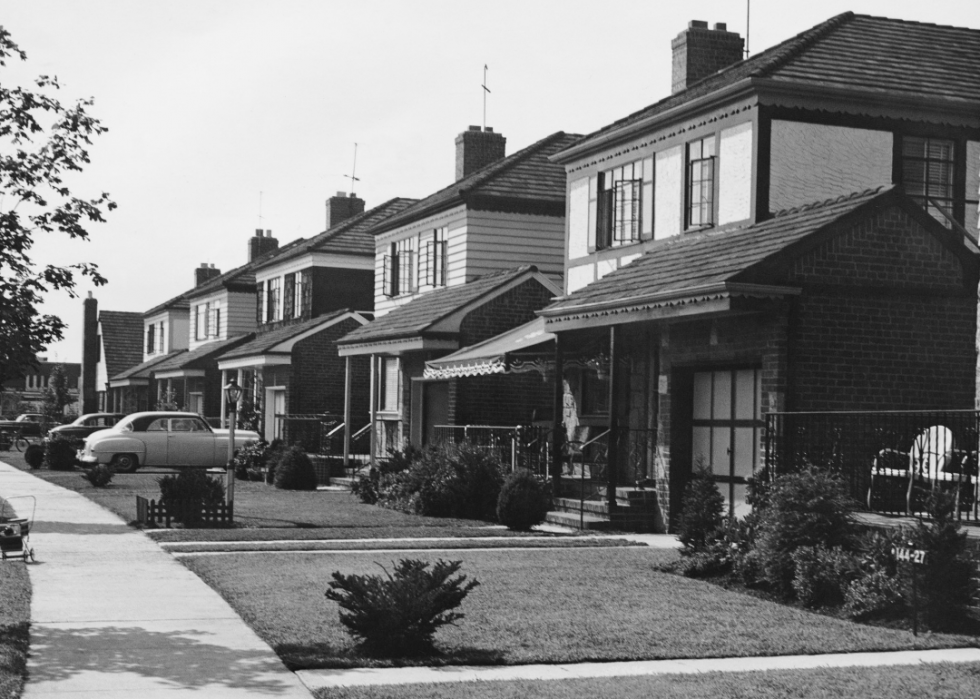
#22. Wyoming
- Median home value in 1950: $6,811
- Median home value (adjusted for inflation): $77,314
- Median home value in 2019: $235,200
The population around Casper, Wyoming, grew by 1,825 people each year between 1950 and 1960. The number of homes increased by 635 yearly in that same period. A report on Wyoming's housing in 2011 found that 13.3% of homes were built in 1939 or earlier, 6.6% dated from 1940 to 1949, and 11.5% were constructed from 1950 to 1959.
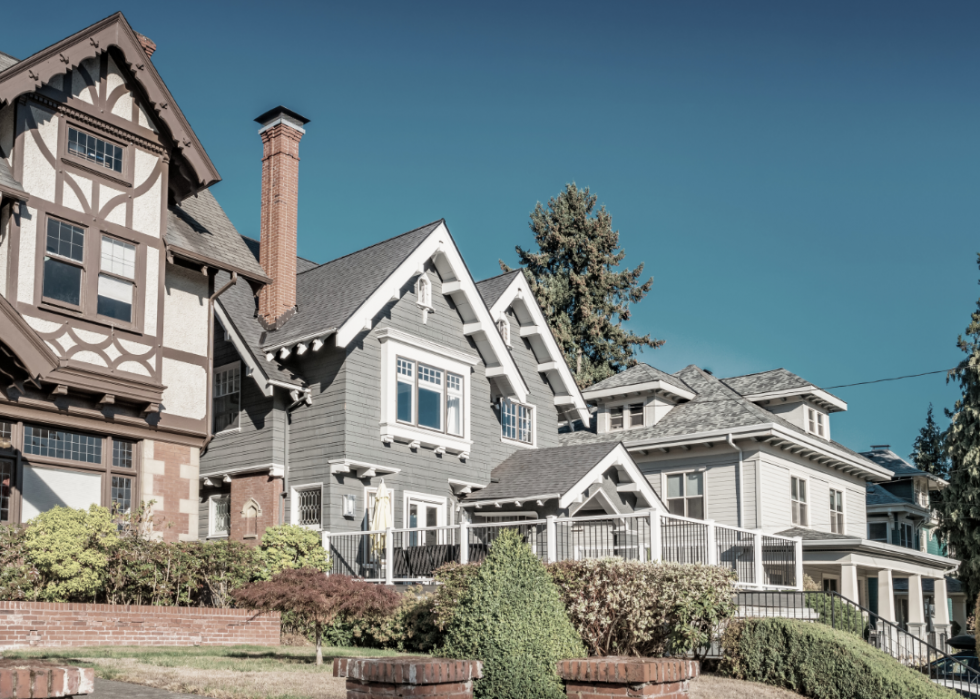
#21. Oregon
- Median home value in 1950: $6,846
- Median home value (adjusted for inflation): $77,711
- Median home value in 2019: $354,600
Cities like Portland, Oregon, saw many downtown businesses move out to newly constructed suburban strips following World War II in order to attract city and suburban residents. Giant parking lots were installed to accommodate shoppers coming in by car and truck. The new shopping centers and roads made living in freshly constructed suburbs increasingly attractive: Oregon's population grew by more than a quarter of a million people in the 1950s.
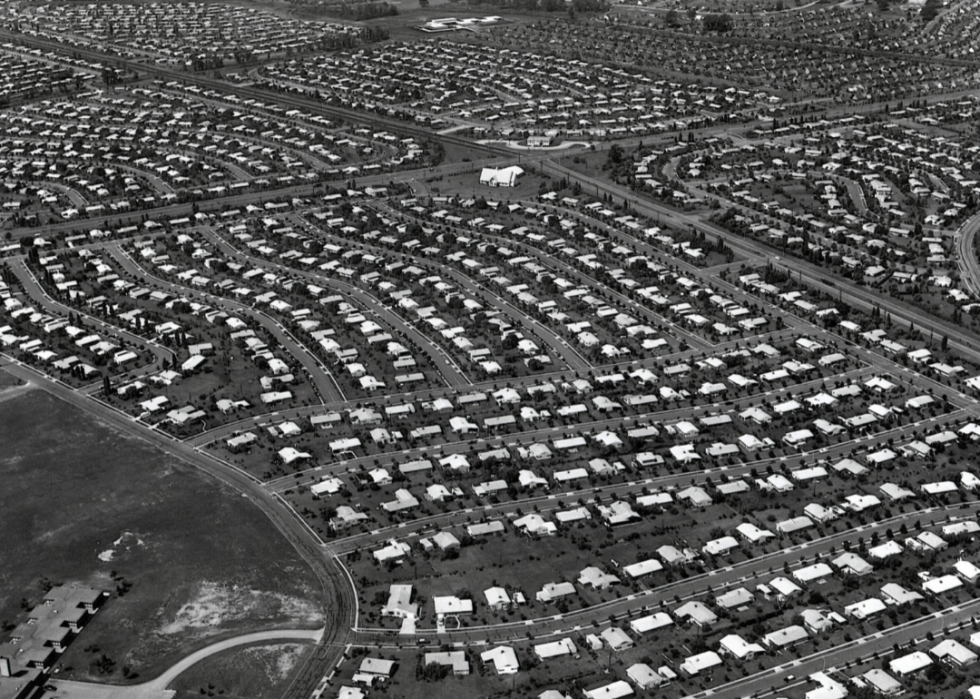
#20. Pennsylvania
- Median home value in 1950: $6,992
- Median home value (adjusted for inflation): $79,368
- Median home value in 2019: $192,600
The population in the Harrisburg, Pennsylvania, area grew by about 5,275 people each year during the decade between 1950 and 1960. During the same period, the number of homes increased by about 2,400 each year, though HUD found a small part of the increase to reflect a change in the definition of a housing unit. In 1950, the housing was divided among 35,546 single-family homes and trailers; 47,364 buildings of two to four apartments; and 4,446 buildings of five or more apartments. Nearly half the homes in the Scranton/Wilkes-Barre metro area were built before 1950, the oldest housing stock in the country.
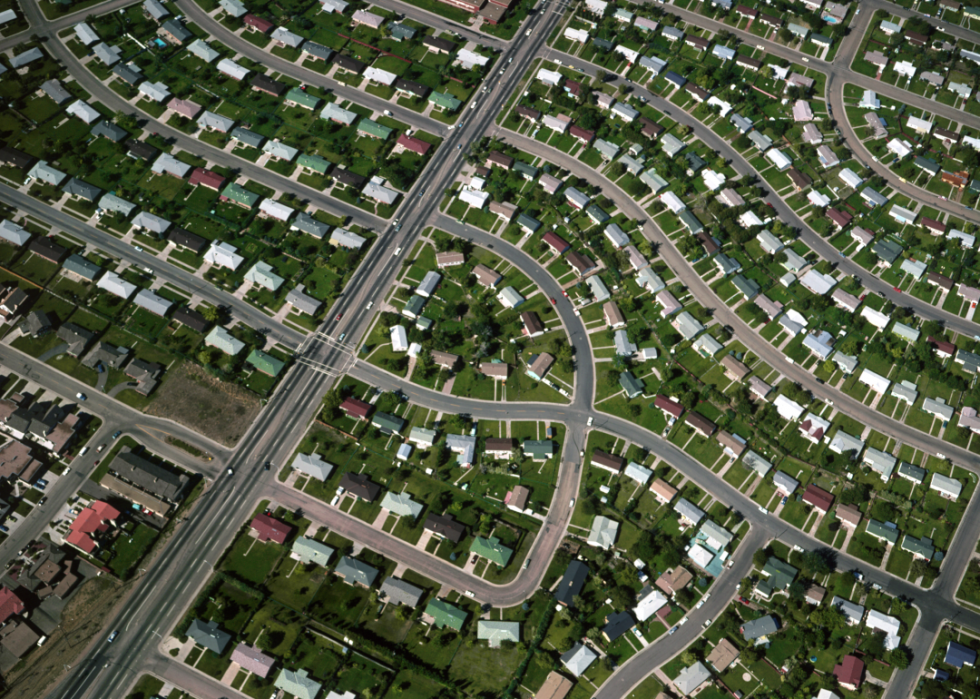
#19. Colorado
- Median home value in 1950: $7,151
- Median home value (adjusted for inflation): $81,173
- Median home value in 2019: $394,600
The population in the Denver area increased from 612,128 in 1950 to 929,383 in 1960 or about 5.2% a year. During that same period, the number of homes increased by 109,400 or about 5.5% a year. In 1950, 29% of the homes were classified as dilapidated or without some indoor plumbing.
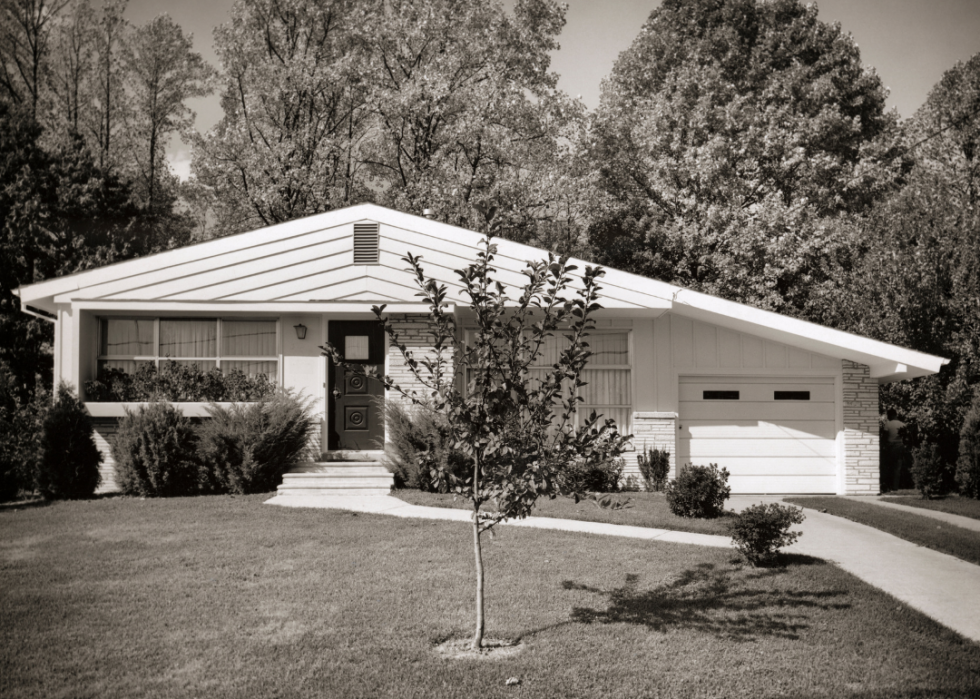
#18. Washington
- Median home value in 1950: $7,169
- Median home value (adjusted for inflation): $81,378
- Median home value in 2019: $387,600
During the Great Depression, the number of building permits issued in Seattle plummeted from $35 million worth of permits in 1928 to less than $2 million in 1933, according to a history of housebuilding in the city. Residential construction fell by 95% by 1932. After World War II, developers constructed inexpensive housing for veterans in the suburbs.
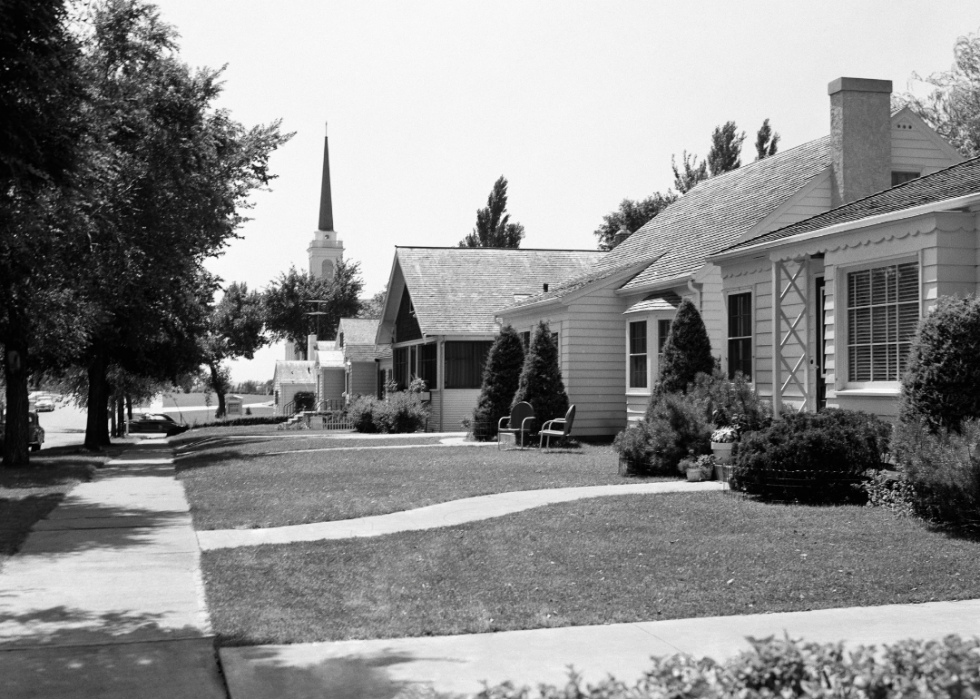
#17. Utah
- Median home value in 1950: $7,409
- Median home value (adjusted for inflation): $84,102
- Median home value in 2019: $330,300
The population around Salt Lake City grew by about 12,700 people a year in the decade between 1950 and 1960. The number of homes increased by 3,750 a year over the decade. By 1966, 38.2% of the housing had been constructed before 1939; 13.7% between 1940 and 1949; 29.3% between 1950 and 1960; and 18.8% from 1960 on. In 1950, 62.5% of the homes were owner-occupied; by 1960, that figure was 69%.
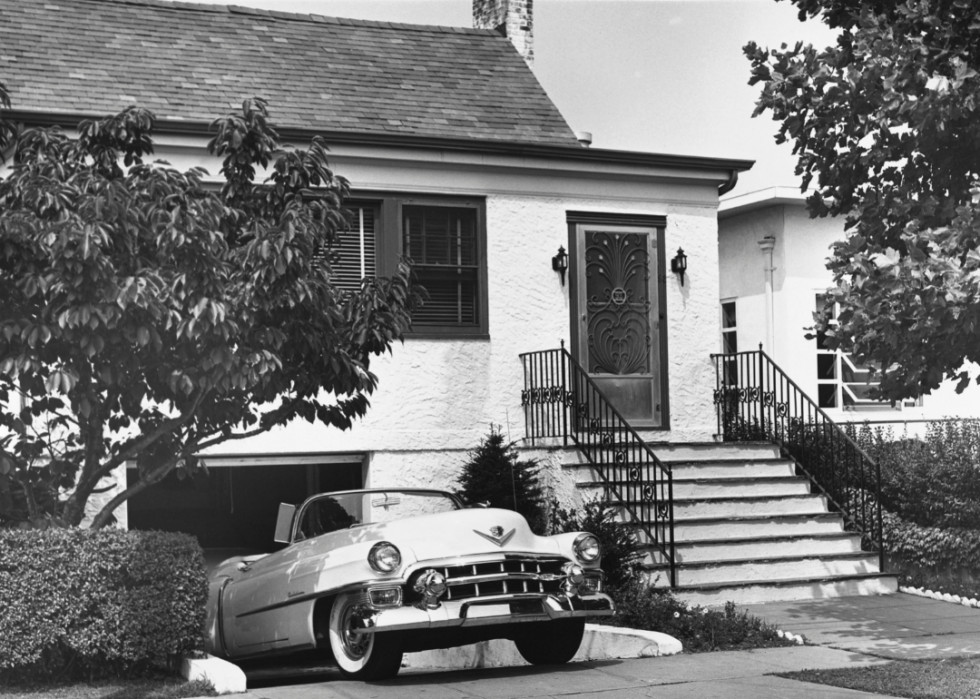
#16. Michigan
- Median home value in 1950: $7,496
- Median home value (adjusted for inflation): $85,090
- Median home value in 2019: $169,600
Detroit and its suburbs were dominated by the auto industry and saw growth of about 74,000 people a year between 1950 and 1960. From the start of the 20th century until 1930, as auto production took off, the city grew by 1.25 million people to 1.57 million. By 1966, the car companies accounted for half of all manufacturing employment and their suppliers accounted for a significant portion of the other half. The number of homes increased by 29,525 a year between 1950 and 1960. A HUD report noted the cyclical nature of the auto business and linked it to the limited amount of speculative building.
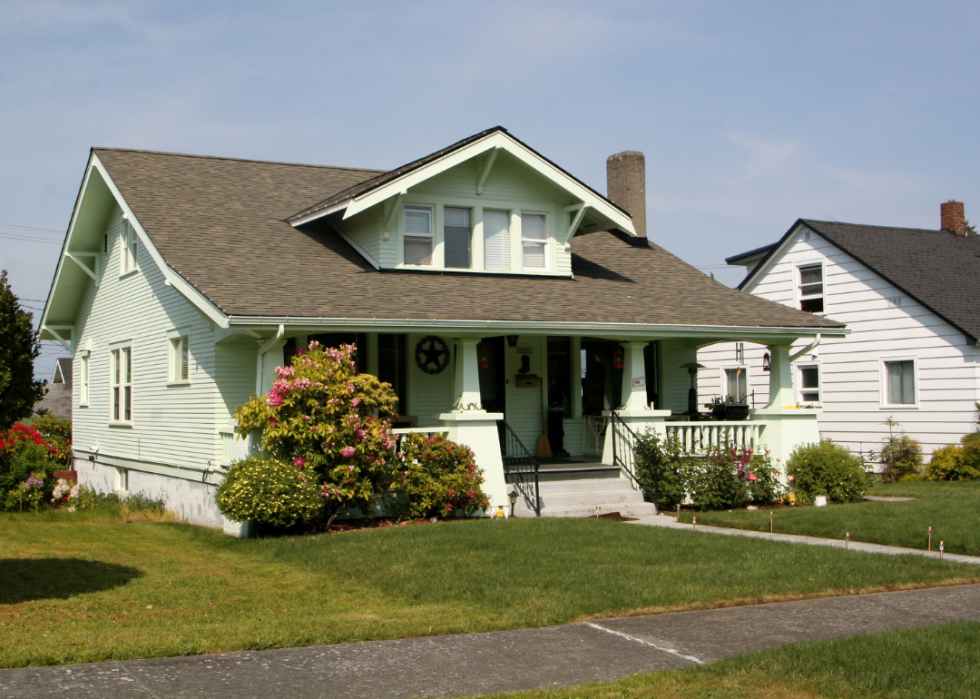
#15. Minnesota
- Median home value in 1950: $7,806
- Median home value (adjusted for inflation): $88,608
- Median home value in 2019: $246,700
The economy of the area around Minneapolis and St. Paul was highly diversified at the juncture of the industrial belt and the northern Plains' farmlands. No single industry dominated the Twin Cities. The rate of job growth was about 2.3% a year. Population growth each year was about 2.9%; by 1965, the population was 1.68 million.
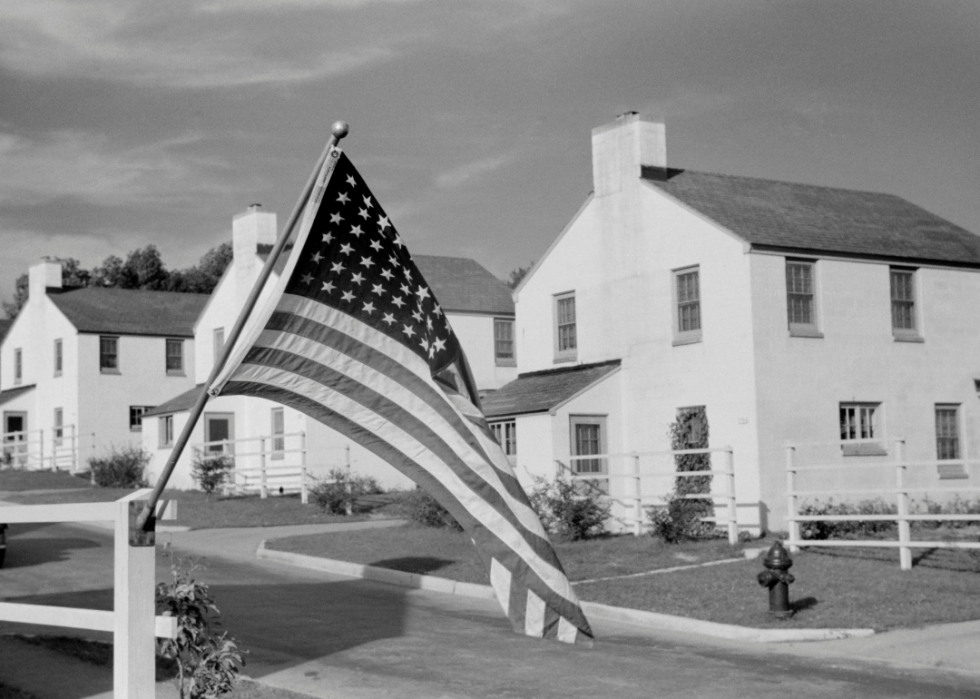
#14. Wisconsin
- Median home value in 1950: $7,927
- Median home value (adjusted for inflation): $89,982
- Median home value in 2019: $197,200
The total number of homes, including farms, in the Madison, Wisconsin, area increased from 48,000 in 1950 to 67,200 a decade later. Among the homes that were not farms, the vast majority—41,288—were single buildings as opposed to apartment units. By 1966, more than 47% of the nonfarm housing had been built since 1950, according to a HUD report.
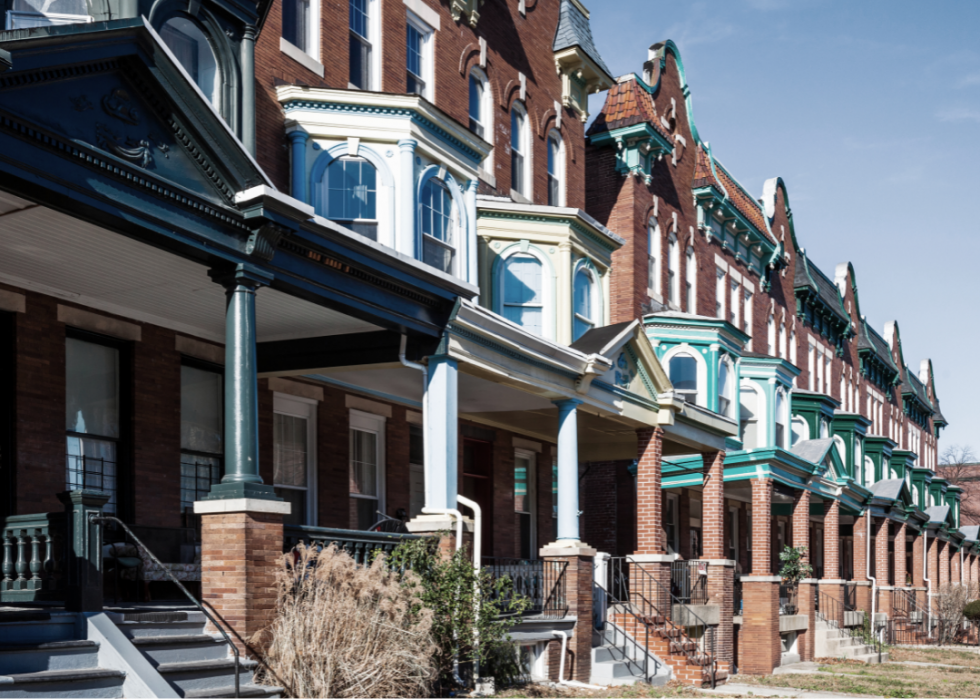
#13. Maryland
- Median home value in 1950: $8,033
- Median home value (adjusted for inflation): $91,185
- Median home value in 2019: $332,500
Almost a quarter of the homes in the Baltimore area were constructed before 1950. As of 2012, that included about 271,000 of the city's 1.13 million homes. The Sparrows Point steel mill, formerly Bethlehem Steel, employed 30,000 workers during the 1950s, though it later closed because of high costs and other problems.
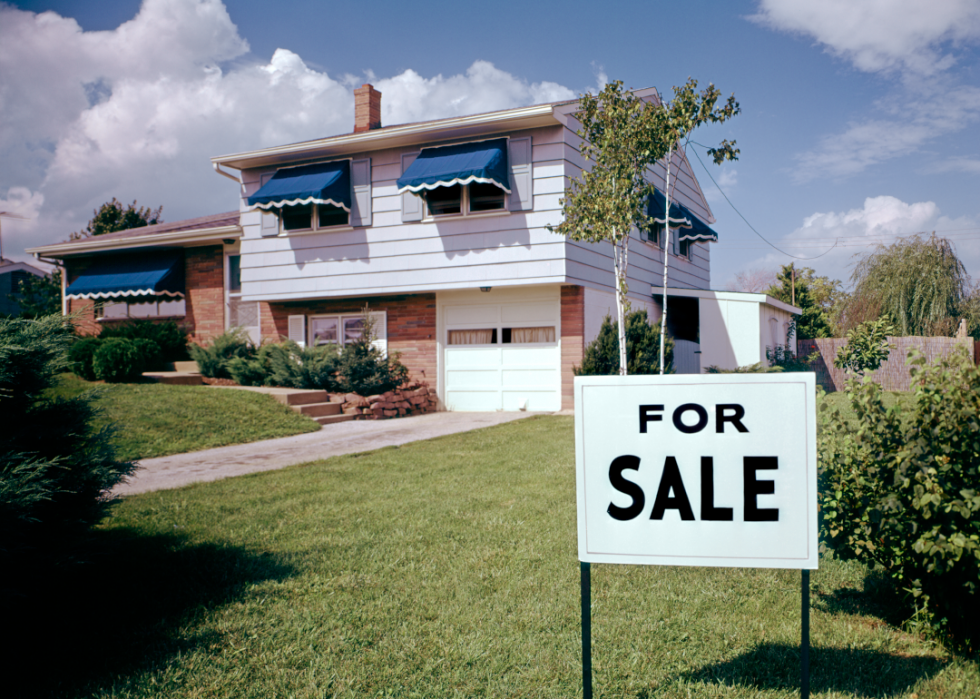
#12. Ohio
- Median home value in 1950: $8,304
- Median home value (adjusted for inflation): $94,261
- Median home value in 2019: $157,200
The ratio of employment to population or so-called "participation rate" in 1950 sat at 39% in the Columbus, Ohio, area. That rate fell to 37.2% in 1960. During World War II, the federal government opened a plant in the area to manufacture naval aircraft, according to a HUD report. After the war, other industries moved in to take advantage of the experienced labor force and transportation, including a division of General Motors, North American Aviation, and Westinghouse Electric.
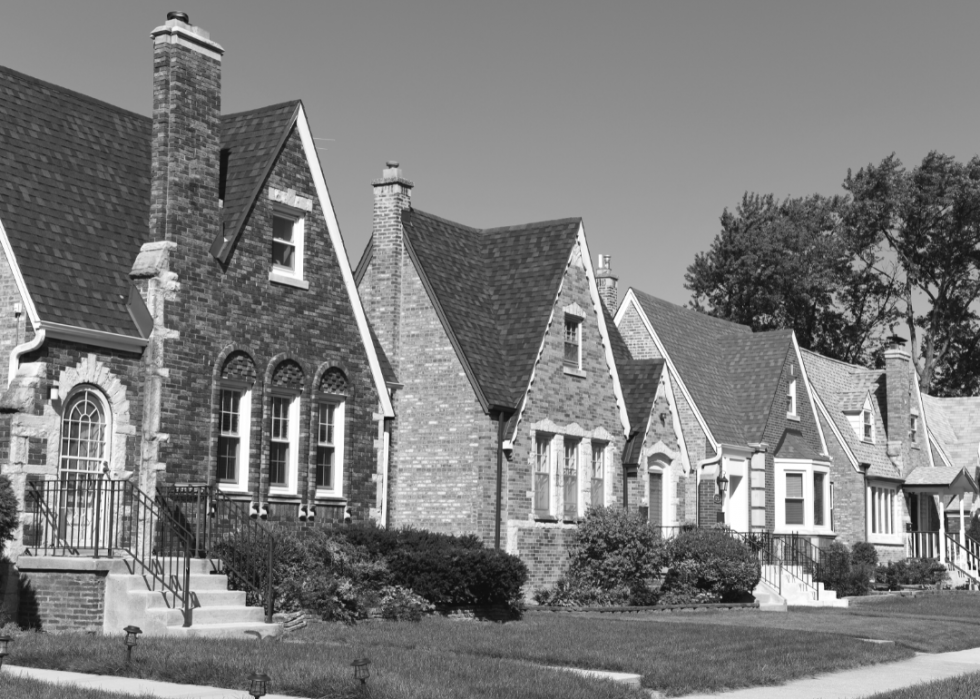
#11. Illinois
- Median home value in 1950: $8,646
- Median home value (adjusted for inflation): $98,144
- Median home value in 2019: $209,100
After World War II, Chicago did not have enough housing—especially not for returning veterans. Overcrowding was a chronic issue for African Americans, many of whom had come north from Southern states seeking jobs in factories.
Meanwhile, quickly developing suburbs threatened Chicago's downtown businesses. Transportation projects that sought to increase downtown development had the opposite effect of even more households and businesses establishing themselves outside of city limits. Forty-two suburban malls were constructed around the city in the 1950s. Chicago's population dropped by almost 100,000 residents between 1950 and 1960—the city's first population drop in history.
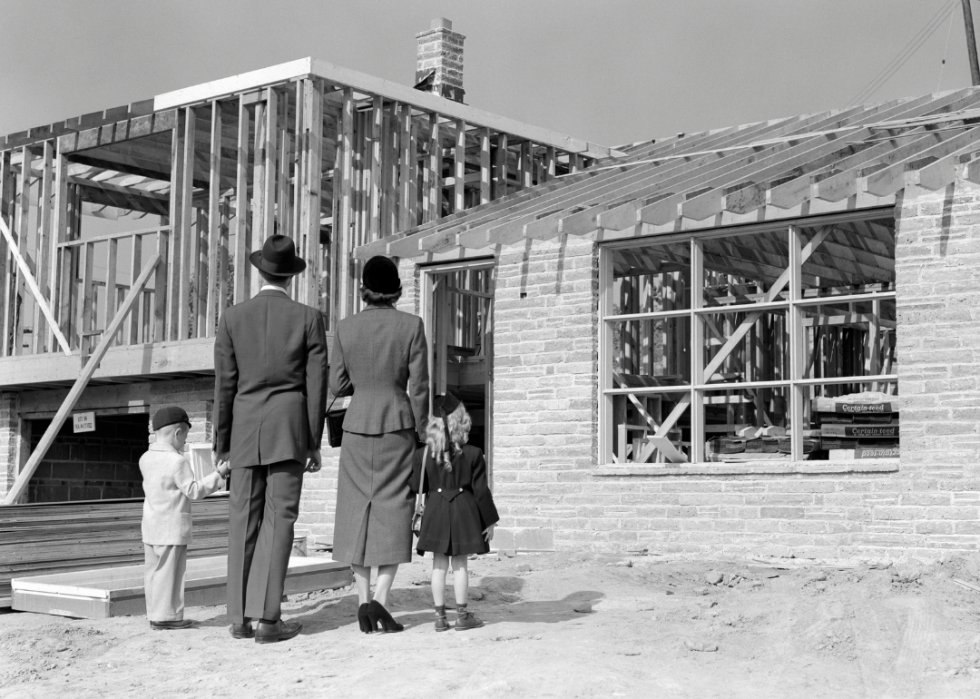
#10. Nevada
- Median home value in 1950: $8,859
- Median home value (adjusted for inflation): $100,561
- Median home value in 2019: $317,800
Land was especially cheap in Las Vegas in the 1950s selling for about $300 an acre or $2,635 in today's dollars. The population of the area grew from 16,414 in 1940 to 48,289 in 1950 to 127,016 in 1960. Between 1940 and 1949, 9,700 homes were built. That number rose to 13,100 between 1950 and 1954.
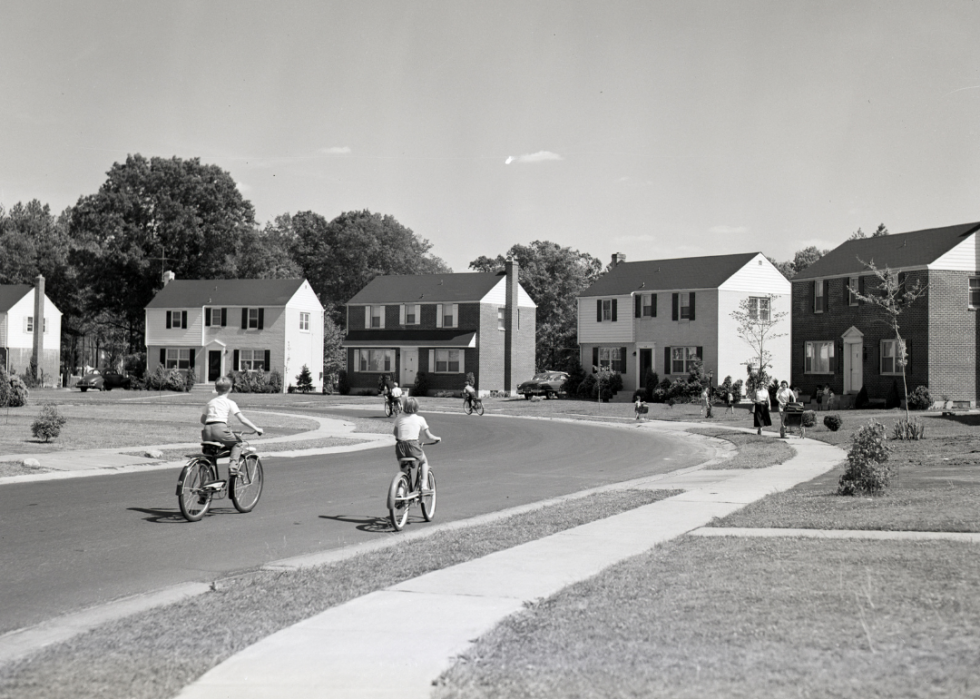
#9. Delaware
- Median home value in 1950: $9,079
- Median home value (adjusted for inflation): $103,059
- Median home value in 2019: $261,700
Homes in the Wilmington, Delaware-Philadelphia-Camden, New Jersey, area are another block of old housing stock, the 17th oldest, according to the Baltimore Business Journal. About a third of the homes were constructed before 1950. Throughout the state, some 21,693 homes were built between 1940 and 1949 and another 34,472 before 1940.
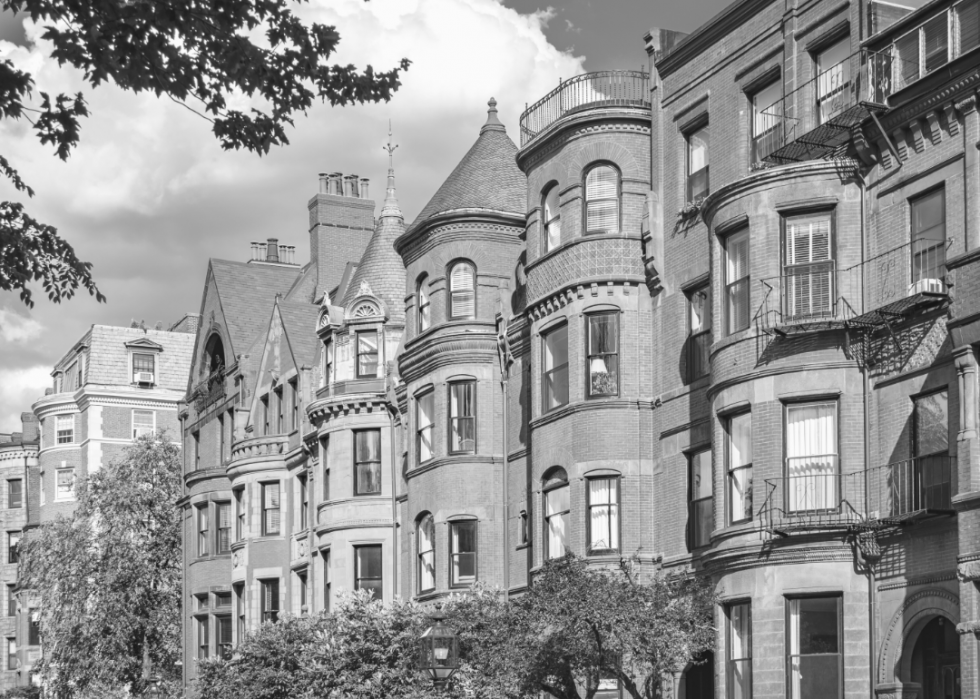
#8. Massachusetts
- Median home value in 1950: $9,144
- Median home value (adjusted for inflation): $103,797
- Median home value in 2019: $418,600
Perhaps the single-largest influencer of the layout suburban sprawl took in 1950s Massachusetts was the infrastructure upgrade of Route 128, a limited-access highway etching a semicircle around North, West, and South Boston. Easing travel routes for increasingly car-dependent households allowed middle-class, residential development outside Boston to expand significantly and quickly.
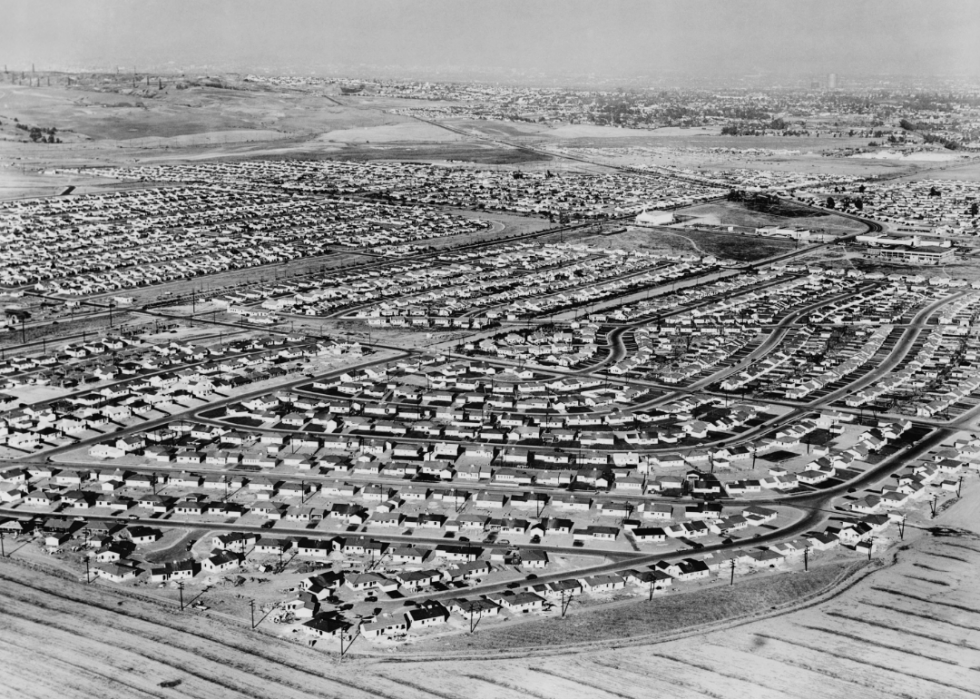
#7. California
- Median home value in 1950: $9,564
- Median home value (adjusted for inflation): $108,564
- Median home value in 2019: $568,500
The 1848 discovery of gold in California sparked a migration to the West. The Los Angeles area's housing inventory totaled about 2.5 million homes in 1966, with a population of 6.98 million. Between 1950 and 1960, housing increased on average by 70,050 homes a year. The number of residents grew on average by 188,700 a year between 1950 and 1960, and 136,600 a year during the 1940s.
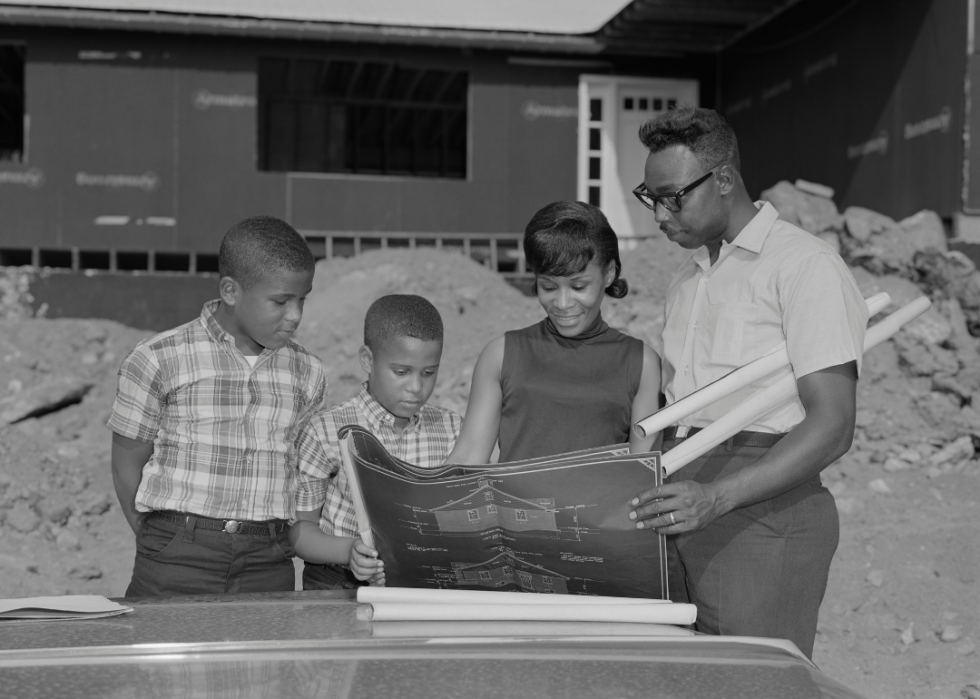
#6. Rhode Island
- Median home value in 1950: $9,767
- Median home value (adjusted for inflation): $110,868
- Median home value in 2019: $283,000
Providence, Rhode Island, suffered a decline as the textile mills that formed the basis of its economy floundered. Employment in the mills dropped from 65,600 in 1939 to 23,500 in 1965. Jobs in machinery, metals, jewelry, silverware filled in the gaps. In 1966, there were 259,800 homes in the Providence area. Housing had increased by about 3,250 homes a year between 1950 and 1960.
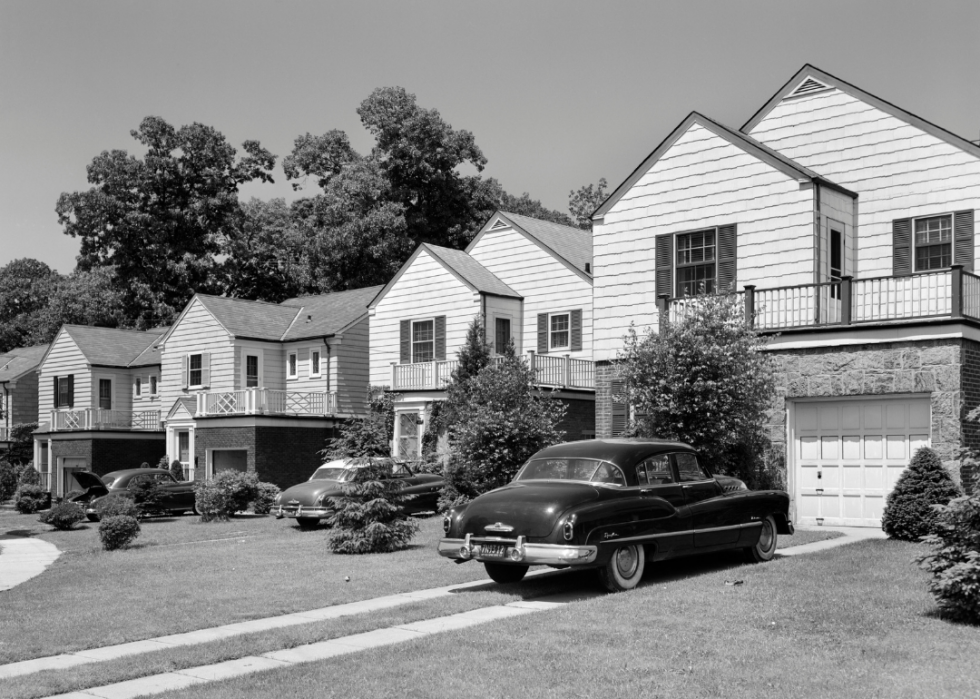
#5. New York
- Median home value in 1950: $10,152
- Median home value (adjusted for inflation): $115,239
- Median home value in 2019: $338,700
New York is home to the first modern American suburb: Levittown on Long Island. The area—formerly a seven-mile area used for potato and onion farming—was bought by developers Levitt and Sons in 1947.
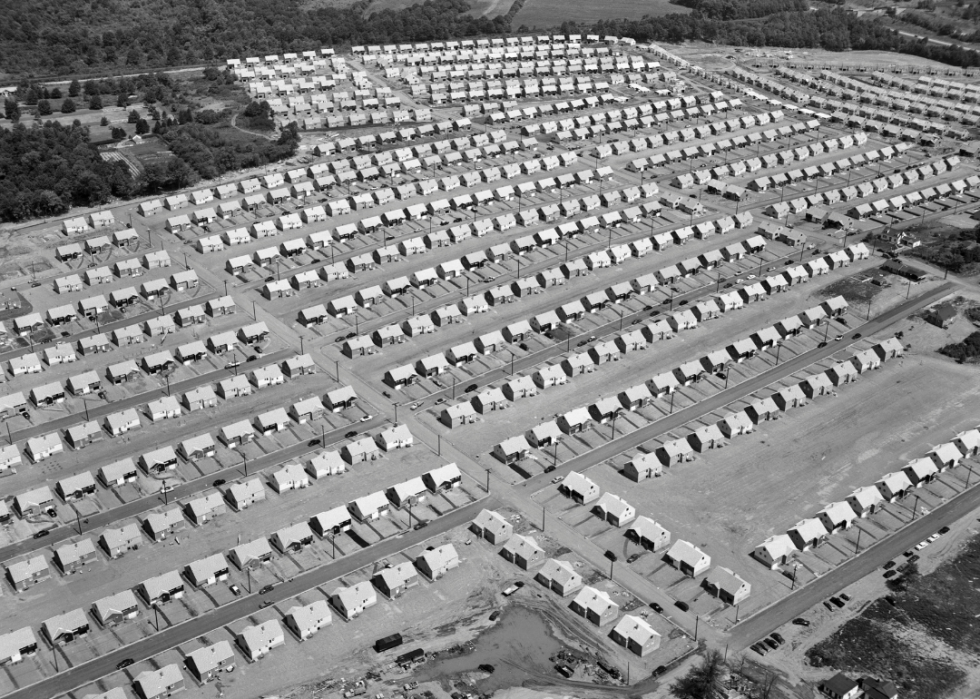
#4. New Jersey
- Median home value in 1950: $10,408
- Median home value (adjusted for inflation): $118,145
- Median home value in 2019: $348,800
The Newark, New Jersey, area grew by about 21,200 people yearly in the decade between 1950 and 1960. By 1965, the population totaled 1.8 million. The city of Newark also grew in the 1940s, but then lost 3,350 residents each year between 1950 and 1960. During that time, the number of homes increased by nearly 11,000 homes a year.
Overall, New Jersey's population ballooned by 50% from 1940 to 1960; but every major city in the state except Paterson saw populations decrease as people fled cities and bought homes in the suburbs. Eventually, 70% of the state was classified as suburban.
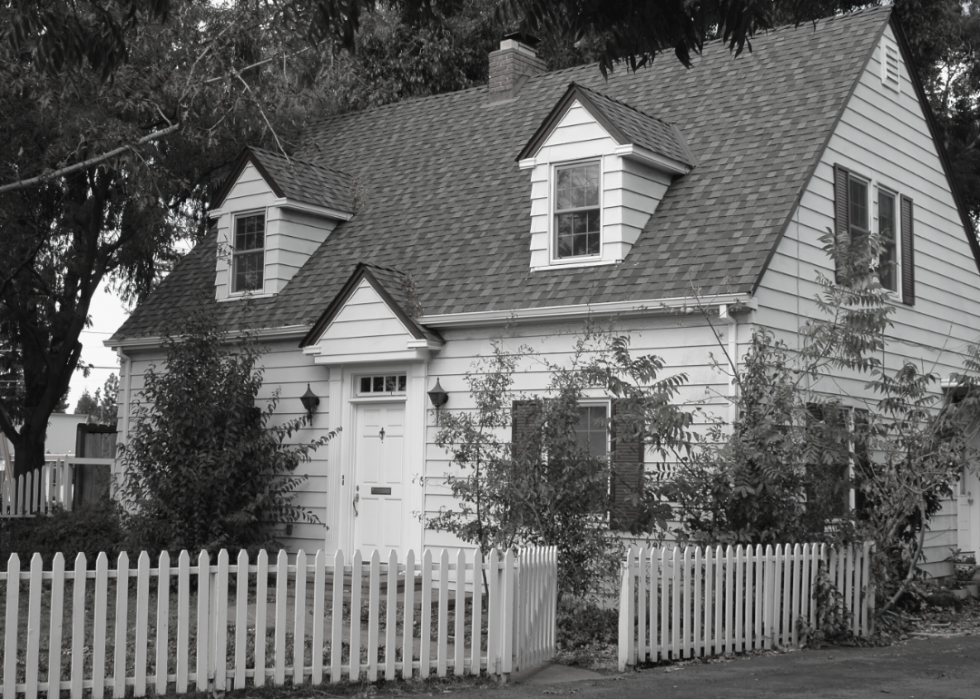
#3. Connecticut
- Median home value in 1950: $11,862
- Median home value (adjusted for inflation): $134,649
- Median home value in 2019: $280,700
In Connecticut, 23% of the homes were constructed before 1939. Another 36% were built between 1940 and 1969, with the remainder, 41%, going up after 1970. In 1950, nearly half of the state's workers, excluding those on farms, were employed in manufacturing. Some 33,600 jobs were in textile mills in 1950, a number that dropped to 2,600 jobs by 1990.
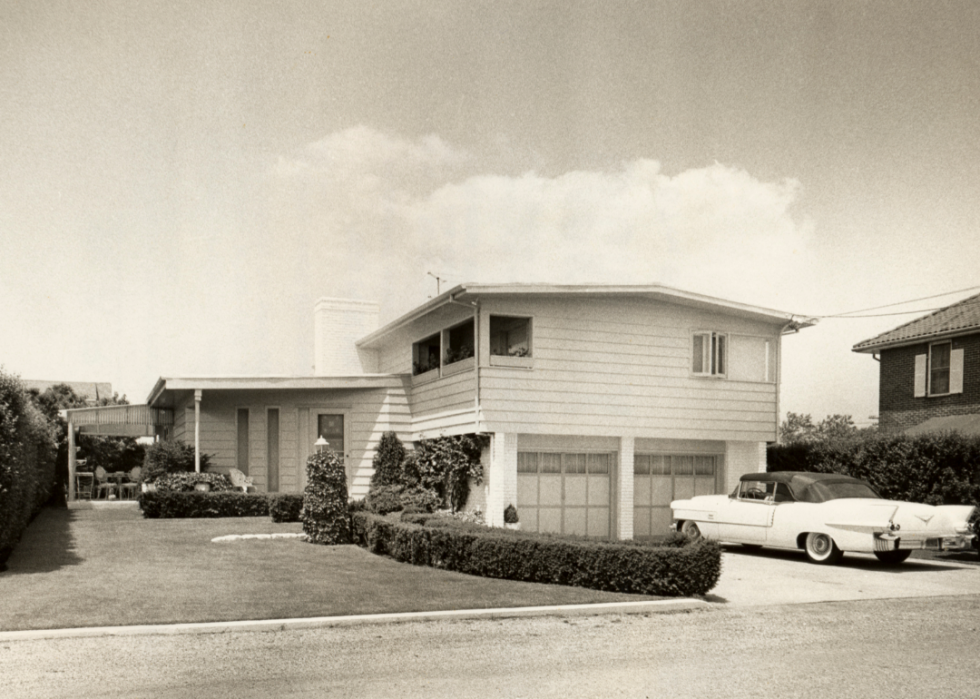
#2. Hawaii
- Median home value in 1950: $12,283
- Median home value (adjusted for inflation): $139,428
- Median home value in 2019: $669,200
After World War II, a wave of migration from neighboring islands in Hawaii drove housing prices up on the Big Island. Mechanization took away jobs on sugar plantations at the same time that tourists began visiting. The tourist industry drove up wages and housing costs, and with little room to expand, supply lagged behind demand.
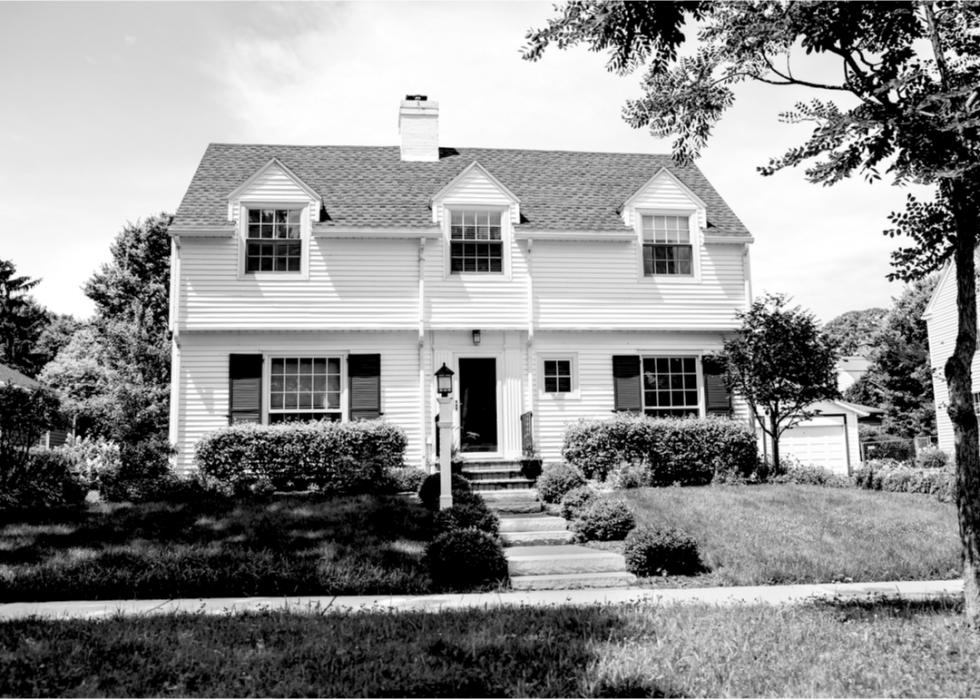
#1. Washington D.C.
- Median home value in 1950: $14,498
- Median home value (adjusted for inflation): $164,572
- Median home value in 2019: $646,500
Nearly 15% of Washington D.C.'s housing was built before 1950, according to the Baltimore Business Journal. The housing market is the 50th oldest in the country. According to the 1950 census, 14.1% of the District's 224,142 homes were classified as "overcrowded.". Of those, 5.3% were found to be "extremely crowded."
A note about our methodology: Home values in this piece represent single-family homes occupied by the owner of the home. The homes are also located on a property of fewer than 10 acres and do not have a business or medical office anywhere on the property. Values for single-family homes are shown in 2021 adjusted dollar and 1950 unadjusted dollar amounts, and states are ranked according to their unadjusted median home value in 1950.



